Business Administration Important Aspect for Business Organization
VerifiedAdded on 2020/07/22
|26
|4617
|36
AI Summary
The assignment emphasizes that business administration is a crucial aspect for business organizations to attain set goals and objectives in an appropriate time frame. It provides references from various books and journals, demonstrating the significance of business administration in managing organizational activities effectively.
Contribute Materials
Your contribution can guide someone’s learning journey. Share your
documents today.
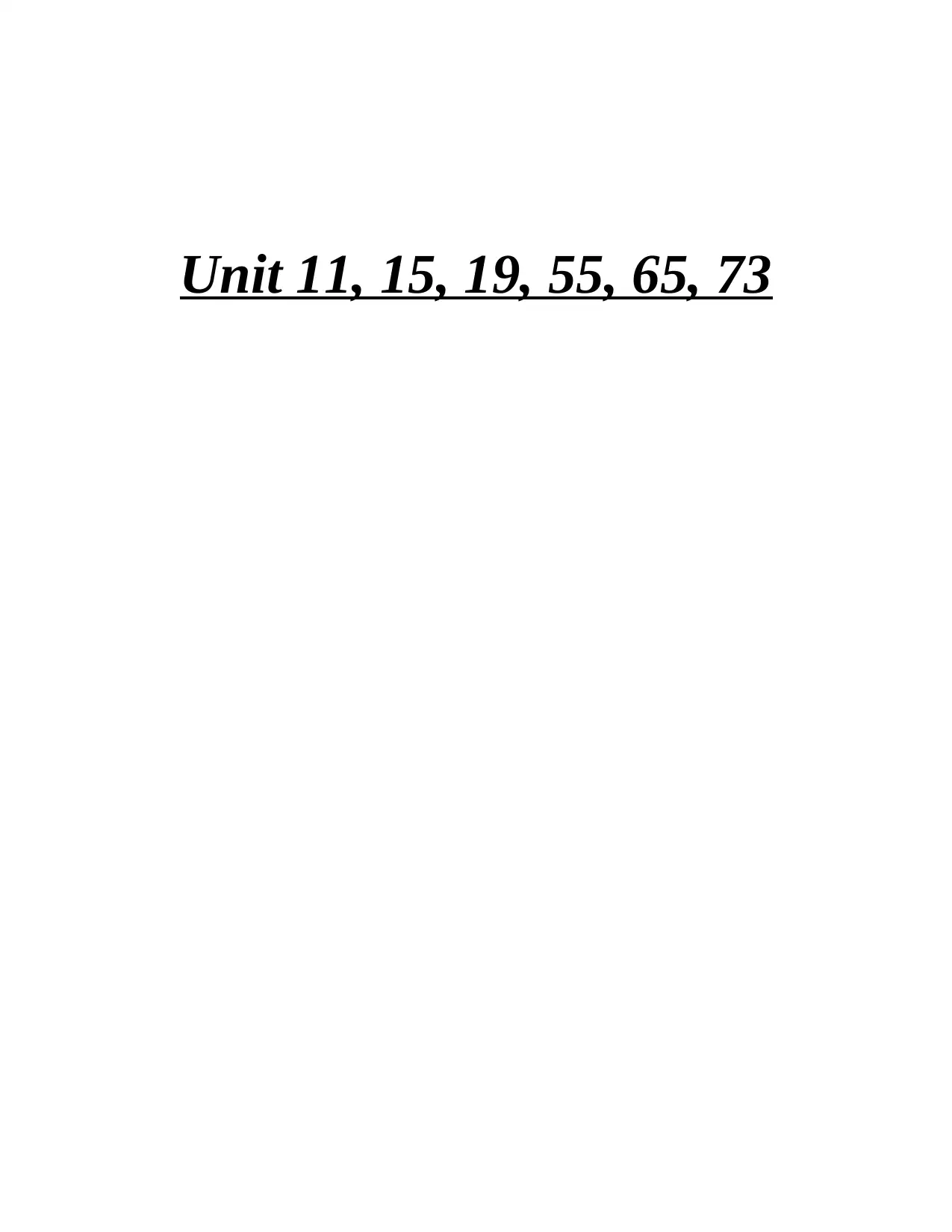
Unit 11, 15, 19, 55, 65, 73
Secure Best Marks with AI Grader
Need help grading? Try our AI Grader for instant feedback on your assignments.
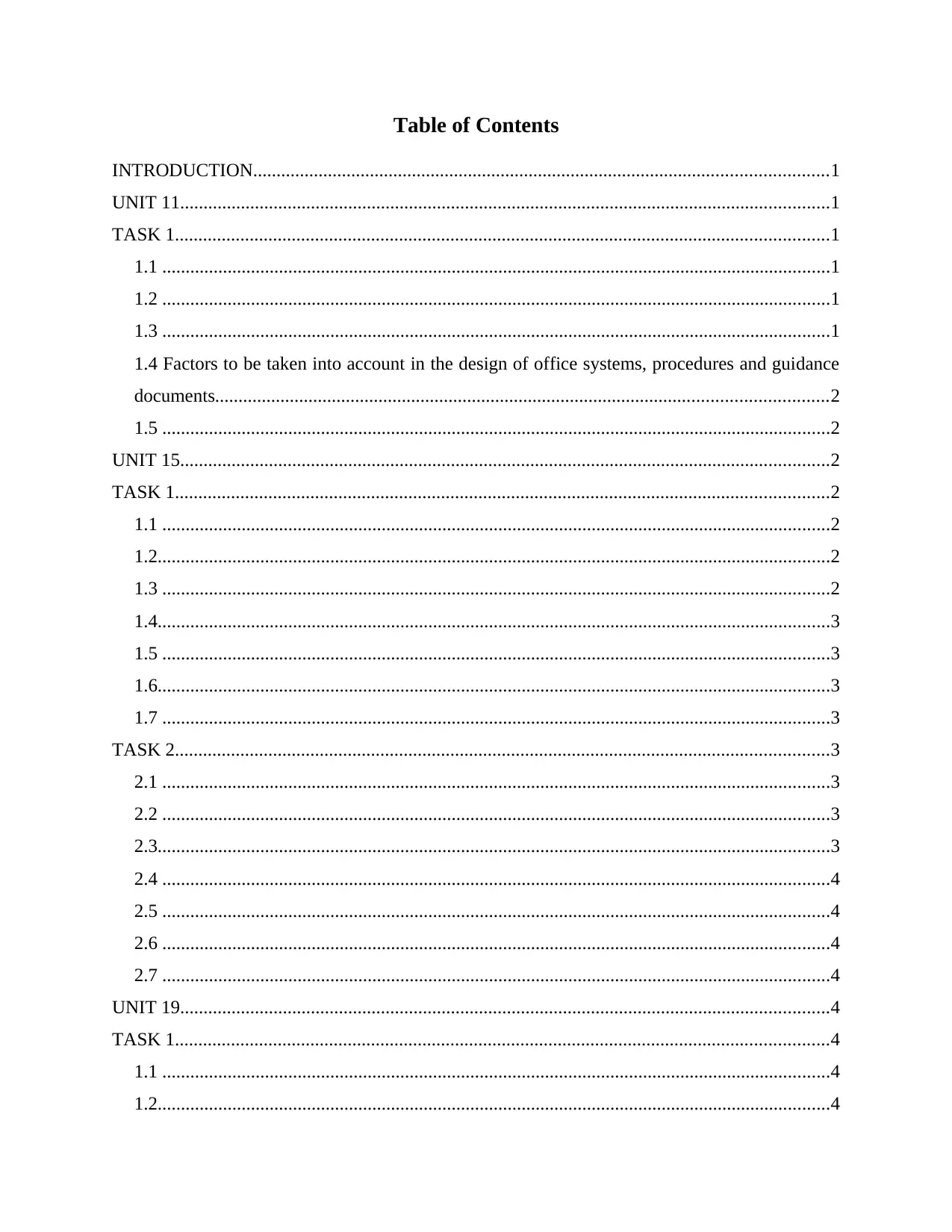
Table of Contents
INTRODUCTION...........................................................................................................................1
UNIT 11...........................................................................................................................................1
TASK 1............................................................................................................................................1
1.1 ...............................................................................................................................................1
1.2 ...............................................................................................................................................1
1.3 ...............................................................................................................................................1
1.4 Factors to be taken into account in the design of office systems, procedures and guidance
documents...................................................................................................................................2
1.5 ...............................................................................................................................................2
UNIT 15...........................................................................................................................................2
TASK 1............................................................................................................................................2
1.1 ...............................................................................................................................................2
1.2................................................................................................................................................2
1.3 ...............................................................................................................................................2
1.4................................................................................................................................................3
1.5 ...............................................................................................................................................3
1.6................................................................................................................................................3
1.7 ...............................................................................................................................................3
TASK 2............................................................................................................................................3
2.1 ...............................................................................................................................................3
2.2 ...............................................................................................................................................3
2.3................................................................................................................................................3
2.4 ...............................................................................................................................................4
2.5 ...............................................................................................................................................4
2.6 ...............................................................................................................................................4
2.7 ...............................................................................................................................................4
UNIT 19...........................................................................................................................................4
TASK 1............................................................................................................................................4
1.1 ...............................................................................................................................................4
1.2................................................................................................................................................4
INTRODUCTION...........................................................................................................................1
UNIT 11...........................................................................................................................................1
TASK 1............................................................................................................................................1
1.1 ...............................................................................................................................................1
1.2 ...............................................................................................................................................1
1.3 ...............................................................................................................................................1
1.4 Factors to be taken into account in the design of office systems, procedures and guidance
documents...................................................................................................................................2
1.5 ...............................................................................................................................................2
UNIT 15...........................................................................................................................................2
TASK 1............................................................................................................................................2
1.1 ...............................................................................................................................................2
1.2................................................................................................................................................2
1.3 ...............................................................................................................................................2
1.4................................................................................................................................................3
1.5 ...............................................................................................................................................3
1.6................................................................................................................................................3
1.7 ...............................................................................................................................................3
TASK 2............................................................................................................................................3
2.1 ...............................................................................................................................................3
2.2 ...............................................................................................................................................3
2.3................................................................................................................................................3
2.4 ...............................................................................................................................................4
2.5 ...............................................................................................................................................4
2.6 ...............................................................................................................................................4
2.7 ...............................................................................................................................................4
UNIT 19...........................................................................................................................................4
TASK 1............................................................................................................................................4
1.1 ...............................................................................................................................................4
1.2................................................................................................................................................4
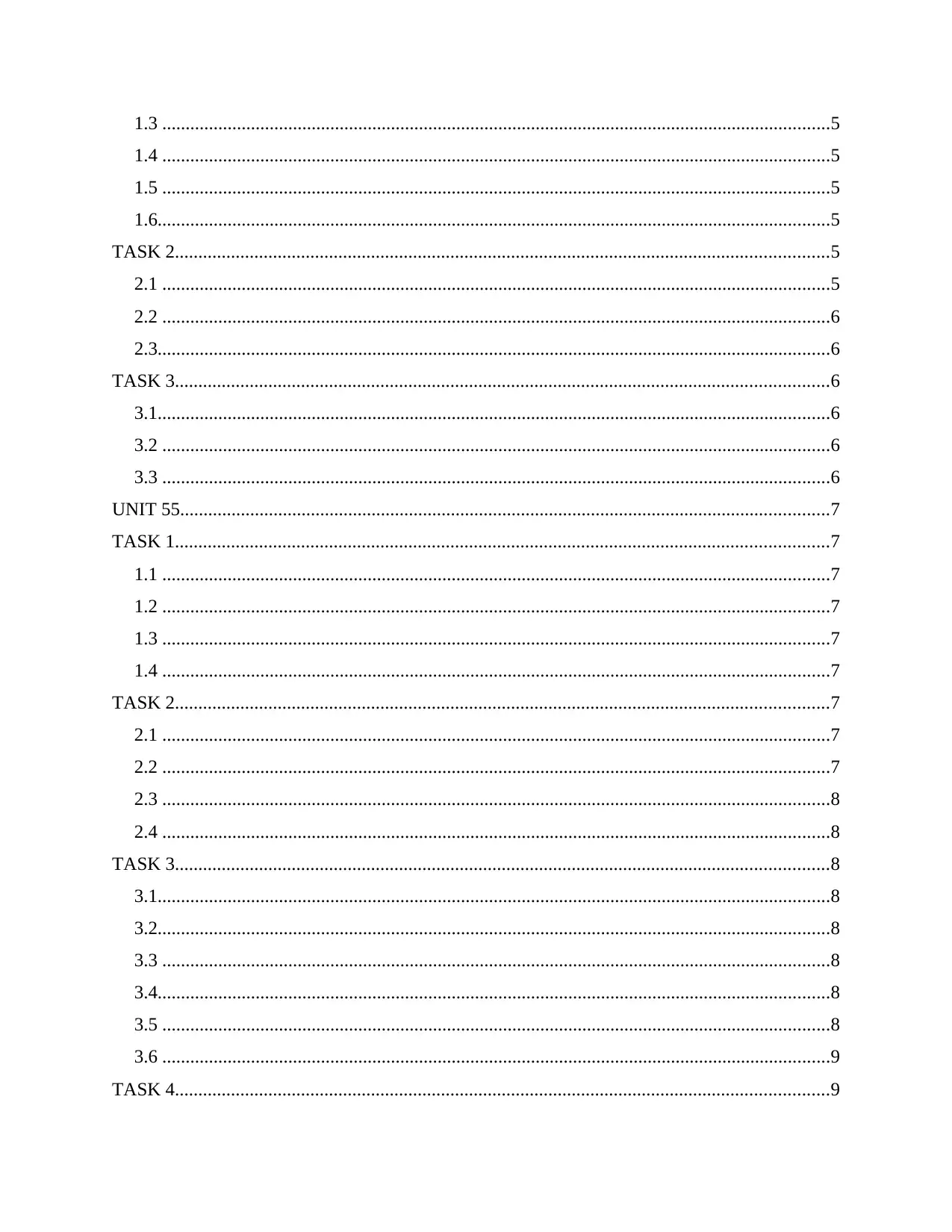
1.3 ...............................................................................................................................................5
1.4 ...............................................................................................................................................5
1.5 ...............................................................................................................................................5
1.6................................................................................................................................................5
TASK 2............................................................................................................................................5
2.1 ...............................................................................................................................................5
2.2 ...............................................................................................................................................6
2.3................................................................................................................................................6
TASK 3............................................................................................................................................6
3.1................................................................................................................................................6
3.2 ...............................................................................................................................................6
3.3 ...............................................................................................................................................6
UNIT 55...........................................................................................................................................7
TASK 1............................................................................................................................................7
1.1 ...............................................................................................................................................7
1.2 ...............................................................................................................................................7
1.3 ...............................................................................................................................................7
1.4 ...............................................................................................................................................7
TASK 2............................................................................................................................................7
2.1 ...............................................................................................................................................7
2.2 ...............................................................................................................................................7
2.3 ...............................................................................................................................................8
2.4 ...............................................................................................................................................8
TASK 3............................................................................................................................................8
3.1................................................................................................................................................8
3.2................................................................................................................................................8
3.3 ...............................................................................................................................................8
3.4................................................................................................................................................8
3.5 ...............................................................................................................................................8
3.6 ...............................................................................................................................................9
TASK 4............................................................................................................................................9
1.4 ...............................................................................................................................................5
1.5 ...............................................................................................................................................5
1.6................................................................................................................................................5
TASK 2............................................................................................................................................5
2.1 ...............................................................................................................................................5
2.2 ...............................................................................................................................................6
2.3................................................................................................................................................6
TASK 3............................................................................................................................................6
3.1................................................................................................................................................6
3.2 ...............................................................................................................................................6
3.3 ...............................................................................................................................................6
UNIT 55...........................................................................................................................................7
TASK 1............................................................................................................................................7
1.1 ...............................................................................................................................................7
1.2 ...............................................................................................................................................7
1.3 ...............................................................................................................................................7
1.4 ...............................................................................................................................................7
TASK 2............................................................................................................................................7
2.1 ...............................................................................................................................................7
2.2 ...............................................................................................................................................7
2.3 ...............................................................................................................................................8
2.4 ...............................................................................................................................................8
TASK 3............................................................................................................................................8
3.1................................................................................................................................................8
3.2................................................................................................................................................8
3.3 ...............................................................................................................................................8
3.4................................................................................................................................................8
3.5 ...............................................................................................................................................8
3.6 ...............................................................................................................................................9
TASK 4............................................................................................................................................9
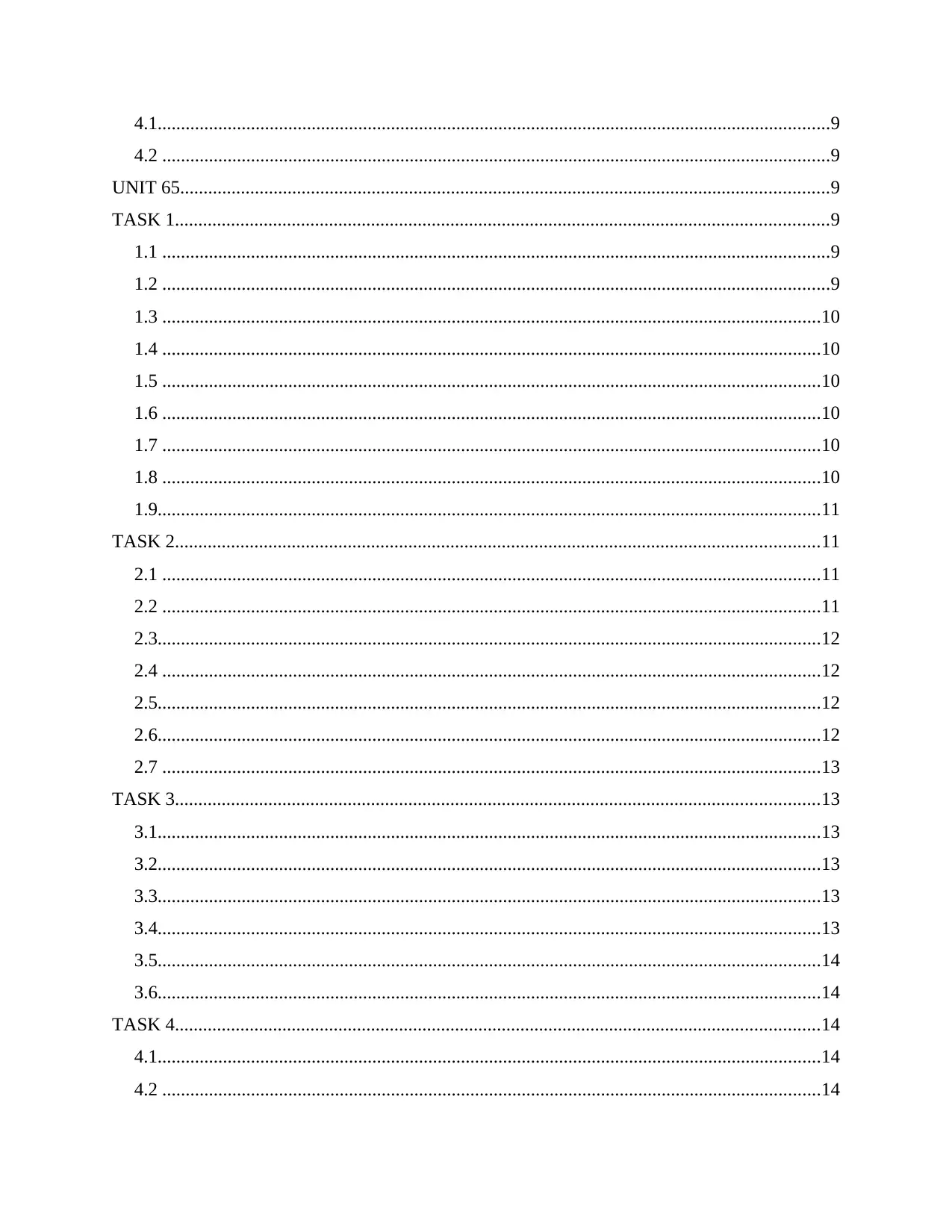
4.1................................................................................................................................................9
4.2 ...............................................................................................................................................9
UNIT 65...........................................................................................................................................9
TASK 1............................................................................................................................................9
1.1 ...............................................................................................................................................9
1.2 ...............................................................................................................................................9
1.3 .............................................................................................................................................10
1.4 .............................................................................................................................................10
1.5 .............................................................................................................................................10
1.6 .............................................................................................................................................10
1.7 .............................................................................................................................................10
1.8 .............................................................................................................................................10
1.9..............................................................................................................................................11
TASK 2..........................................................................................................................................11
2.1 .............................................................................................................................................11
2.2 .............................................................................................................................................11
2.3..............................................................................................................................................12
2.4 .............................................................................................................................................12
2.5..............................................................................................................................................12
2.6..............................................................................................................................................12
2.7 .............................................................................................................................................13
TASK 3..........................................................................................................................................13
3.1..............................................................................................................................................13
3.2..............................................................................................................................................13
3.3..............................................................................................................................................13
3.4..............................................................................................................................................13
3.5..............................................................................................................................................14
3.6..............................................................................................................................................14
TASK 4..........................................................................................................................................14
4.1..............................................................................................................................................14
4.2 .............................................................................................................................................14
4.2 ...............................................................................................................................................9
UNIT 65...........................................................................................................................................9
TASK 1............................................................................................................................................9
1.1 ...............................................................................................................................................9
1.2 ...............................................................................................................................................9
1.3 .............................................................................................................................................10
1.4 .............................................................................................................................................10
1.5 .............................................................................................................................................10
1.6 .............................................................................................................................................10
1.7 .............................................................................................................................................10
1.8 .............................................................................................................................................10
1.9..............................................................................................................................................11
TASK 2..........................................................................................................................................11
2.1 .............................................................................................................................................11
2.2 .............................................................................................................................................11
2.3..............................................................................................................................................12
2.4 .............................................................................................................................................12
2.5..............................................................................................................................................12
2.6..............................................................................................................................................12
2.7 .............................................................................................................................................13
TASK 3..........................................................................................................................................13
3.1..............................................................................................................................................13
3.2..............................................................................................................................................13
3.3..............................................................................................................................................13
3.4..............................................................................................................................................13
3.5..............................................................................................................................................14
3.6..............................................................................................................................................14
TASK 4..........................................................................................................................................14
4.1..............................................................................................................................................14
4.2 .............................................................................................................................................14
Secure Best Marks with AI Grader
Need help grading? Try our AI Grader for instant feedback on your assignments.
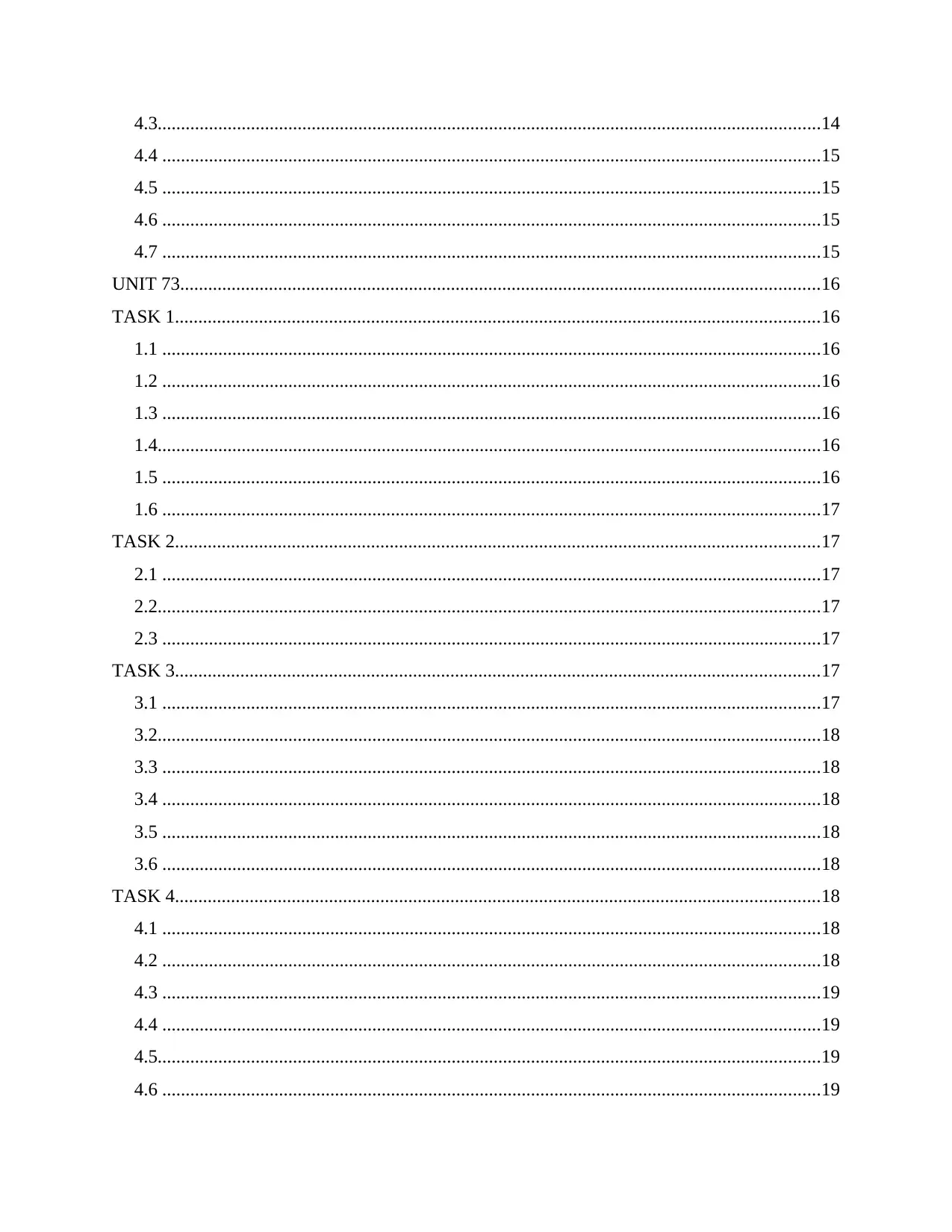
4.3..............................................................................................................................................14
4.4 .............................................................................................................................................15
4.5 .............................................................................................................................................15
4.6 .............................................................................................................................................15
4.7 .............................................................................................................................................15
UNIT 73.........................................................................................................................................16
TASK 1..........................................................................................................................................16
1.1 .............................................................................................................................................16
1.2 .............................................................................................................................................16
1.3 .............................................................................................................................................16
1.4..............................................................................................................................................16
1.5 .............................................................................................................................................16
1.6 .............................................................................................................................................17
TASK 2..........................................................................................................................................17
2.1 .............................................................................................................................................17
2.2..............................................................................................................................................17
2.3 .............................................................................................................................................17
TASK 3..........................................................................................................................................17
3.1 .............................................................................................................................................17
3.2..............................................................................................................................................18
3.3 .............................................................................................................................................18
3.4 .............................................................................................................................................18
3.5 .............................................................................................................................................18
3.6 .............................................................................................................................................18
TASK 4..........................................................................................................................................18
4.1 .............................................................................................................................................18
4.2 .............................................................................................................................................18
4.3 .............................................................................................................................................19
4.4 .............................................................................................................................................19
4.5..............................................................................................................................................19
4.6 .............................................................................................................................................19
4.4 .............................................................................................................................................15
4.5 .............................................................................................................................................15
4.6 .............................................................................................................................................15
4.7 .............................................................................................................................................15
UNIT 73.........................................................................................................................................16
TASK 1..........................................................................................................................................16
1.1 .............................................................................................................................................16
1.2 .............................................................................................................................................16
1.3 .............................................................................................................................................16
1.4..............................................................................................................................................16
1.5 .............................................................................................................................................16
1.6 .............................................................................................................................................17
TASK 2..........................................................................................................................................17
2.1 .............................................................................................................................................17
2.2..............................................................................................................................................17
2.3 .............................................................................................................................................17
TASK 3..........................................................................................................................................17
3.1 .............................................................................................................................................17
3.2..............................................................................................................................................18
3.3 .............................................................................................................................................18
3.4 .............................................................................................................................................18
3.5 .............................................................................................................................................18
3.6 .............................................................................................................................................18
TASK 4..........................................................................................................................................18
4.1 .............................................................................................................................................18
4.2 .............................................................................................................................................18
4.3 .............................................................................................................................................19
4.4 .............................................................................................................................................19
4.5..............................................................................................................................................19
4.6 .............................................................................................................................................19
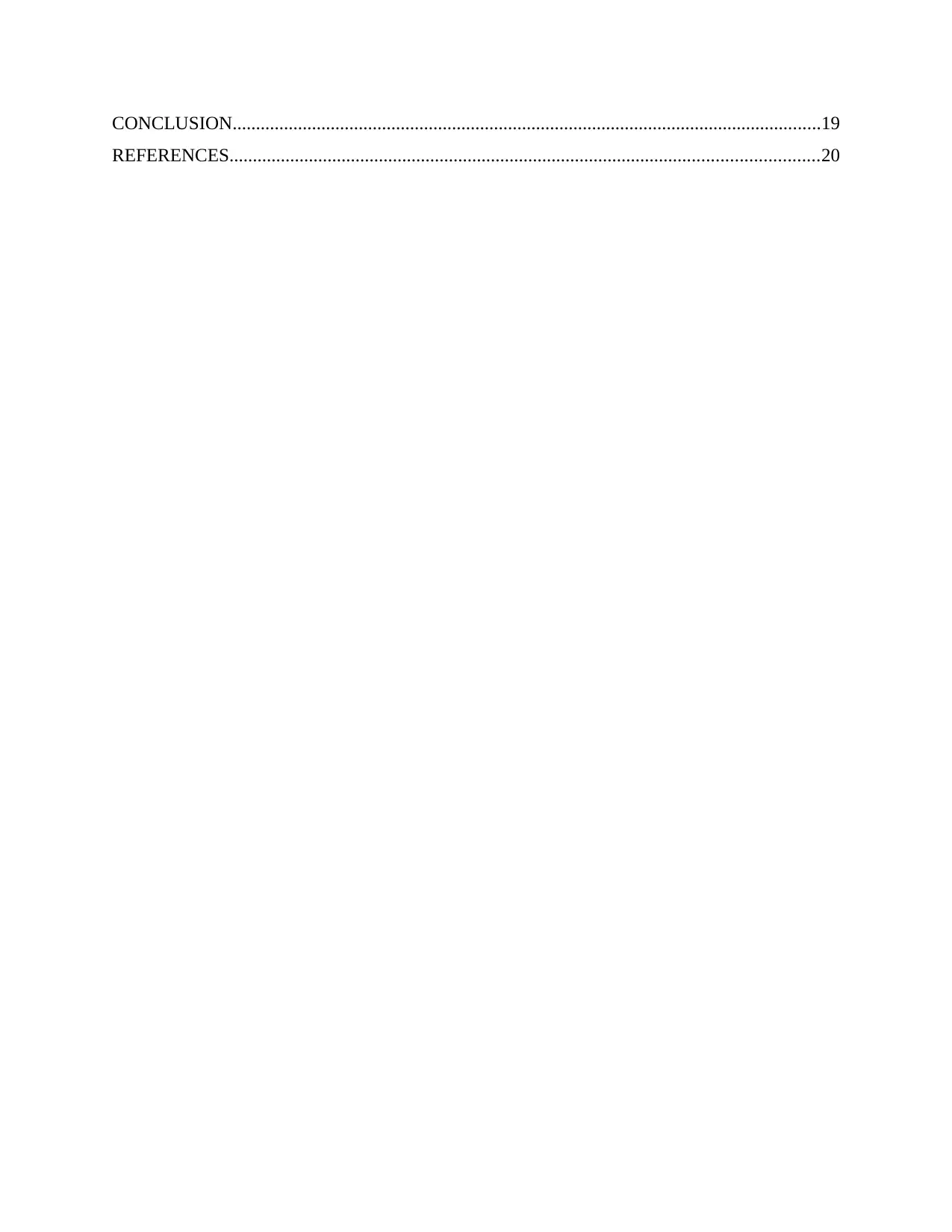
CONCLUSION..............................................................................................................................19
REFERENCES..............................................................................................................................20
REFERENCES..............................................................................................................................20
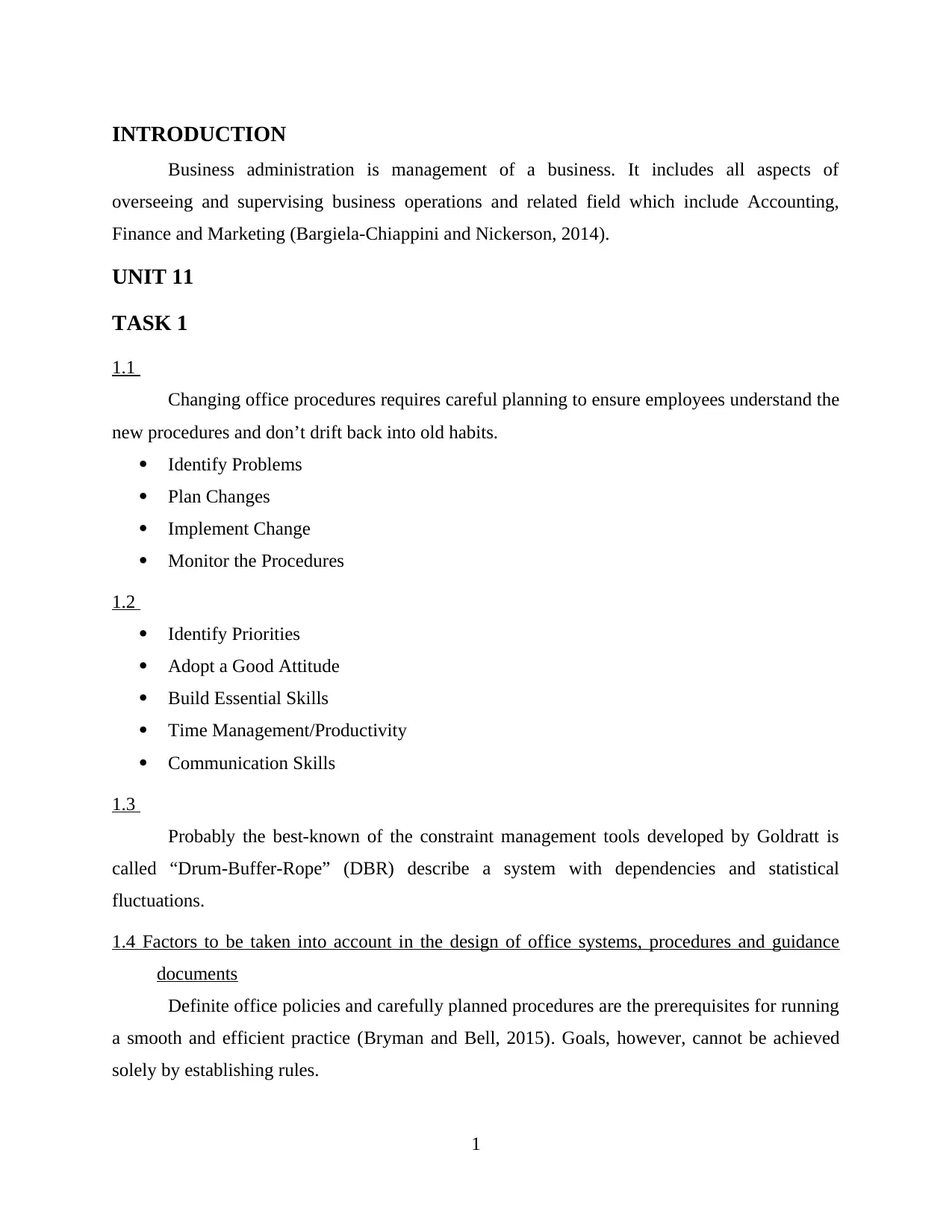
INTRODUCTION
Business administration is management of a business. It includes all aspects of
overseeing and supervising business operations and related field which include Accounting,
Finance and Marketing (Bargiela-Chiappini and Nickerson, 2014).
UNIT 11
TASK 1
1.1
Changing office procedures requires careful planning to ensure employees understand the
new procedures and don’t drift back into old habits.
Identify Problems
Plan Changes
Implement Change
Monitor the Procedures
1.2
Identify Priorities
Adopt a Good Attitude
Build Essential Skills
Time Management/Productivity
Communication Skills
1.3
Probably the best-known of the constraint management tools developed by Goldratt is
called “Drum-Buffer-Rope” (DBR) describe a system with dependencies and statistical
fluctuations.
1.4 Factors to be taken into account in the design of office systems, procedures and guidance
documents
Definite office policies and carefully planned procedures are the prerequisites for running
a smooth and efficient practice (Bryman and Bell, 2015). Goals, however, cannot be achieved
solely by establishing rules.
1
Business administration is management of a business. It includes all aspects of
overseeing and supervising business operations and related field which include Accounting,
Finance and Marketing (Bargiela-Chiappini and Nickerson, 2014).
UNIT 11
TASK 1
1.1
Changing office procedures requires careful planning to ensure employees understand the
new procedures and don’t drift back into old habits.
Identify Problems
Plan Changes
Implement Change
Monitor the Procedures
1.2
Identify Priorities
Adopt a Good Attitude
Build Essential Skills
Time Management/Productivity
Communication Skills
1.3
Probably the best-known of the constraint management tools developed by Goldratt is
called “Drum-Buffer-Rope” (DBR) describe a system with dependencies and statistical
fluctuations.
1.4 Factors to be taken into account in the design of office systems, procedures and guidance
documents
Definite office policies and carefully planned procedures are the prerequisites for running
a smooth and efficient practice (Bryman and Bell, 2015). Goals, however, cannot be achieved
solely by establishing rules.
1
Paraphrase This Document
Need a fresh take? Get an instant paraphrase of this document with our AI Paraphraser
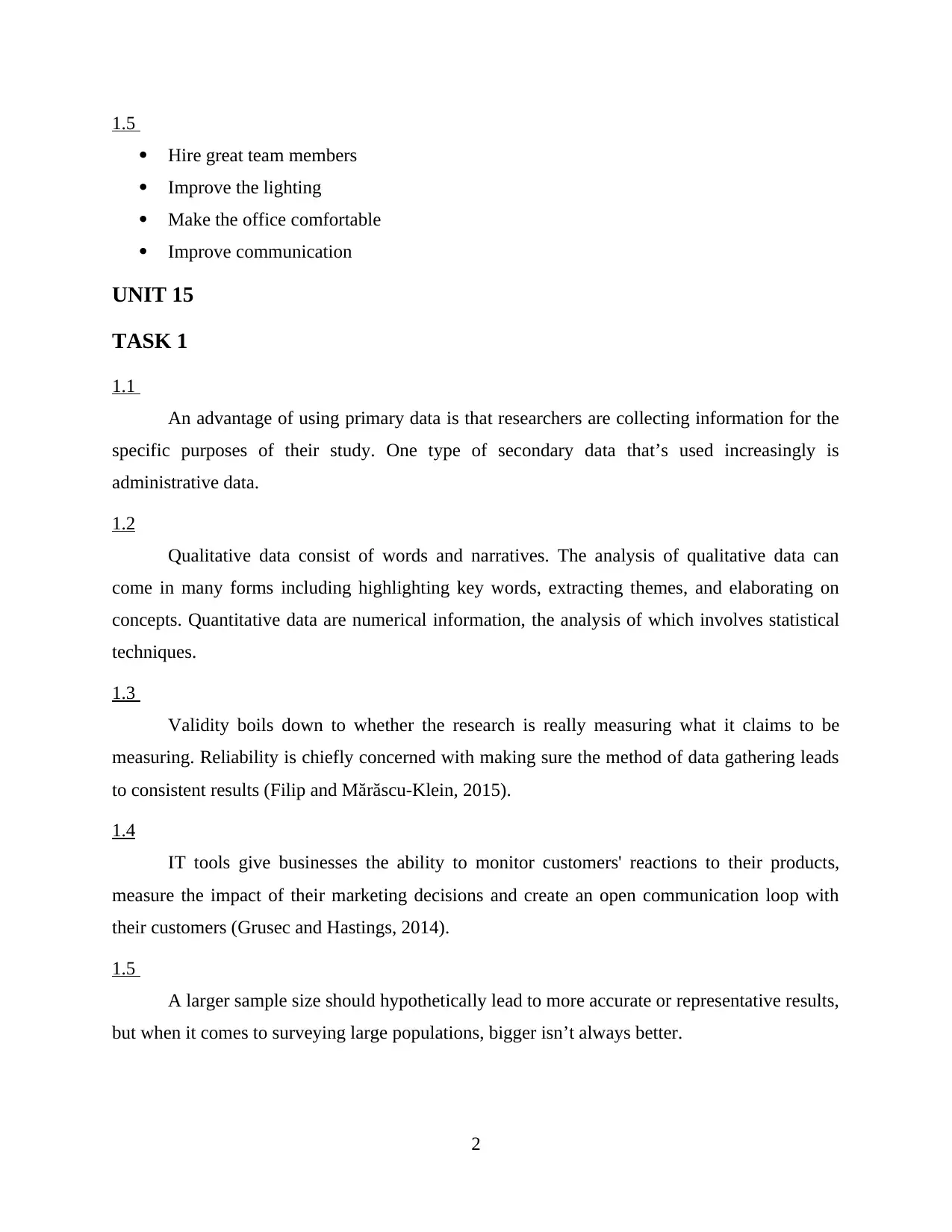
1.5
Hire great team members
Improve the lighting
Make the office comfortable
Improve communication
UNIT 15
TASK 1
1.1
An advantage of using primary data is that researchers are collecting information for the
specific purposes of their study. One type of secondary data that’s used increasingly is
administrative data.
1.2
Qualitative data consist of words and narratives. The analysis of qualitative data can
come in many forms including highlighting key words, extracting themes, and elaborating on
concepts. Quantitative data are numerical information, the analysis of which involves statistical
techniques.
1.3
Validity boils down to whether the research is really measuring what it claims to be
measuring. Reliability is chiefly concerned with making sure the method of data gathering leads
to consistent results (Filip and Mărăscu-Klein, 2015).
1.4
IT tools give businesses the ability to monitor customers' reactions to their products,
measure the impact of their marketing decisions and create an open communication loop with
their customers (Grusec and Hastings, 2014).
1.5
A larger sample size should hypothetically lead to more accurate or representative results,
but when it comes to surveying large populations, bigger isn’t always better.
2
Hire great team members
Improve the lighting
Make the office comfortable
Improve communication
UNIT 15
TASK 1
1.1
An advantage of using primary data is that researchers are collecting information for the
specific purposes of their study. One type of secondary data that’s used increasingly is
administrative data.
1.2
Qualitative data consist of words and narratives. The analysis of qualitative data can
come in many forms including highlighting key words, extracting themes, and elaborating on
concepts. Quantitative data are numerical information, the analysis of which involves statistical
techniques.
1.3
Validity boils down to whether the research is really measuring what it claims to be
measuring. Reliability is chiefly concerned with making sure the method of data gathering leads
to consistent results (Filip and Mărăscu-Klein, 2015).
1.4
IT tools give businesses the ability to monitor customers' reactions to their products,
measure the impact of their marketing decisions and create an open communication loop with
their customers (Grusec and Hastings, 2014).
1.5
A larger sample size should hypothetically lead to more accurate or representative results,
but when it comes to surveying large populations, bigger isn’t always better.
2
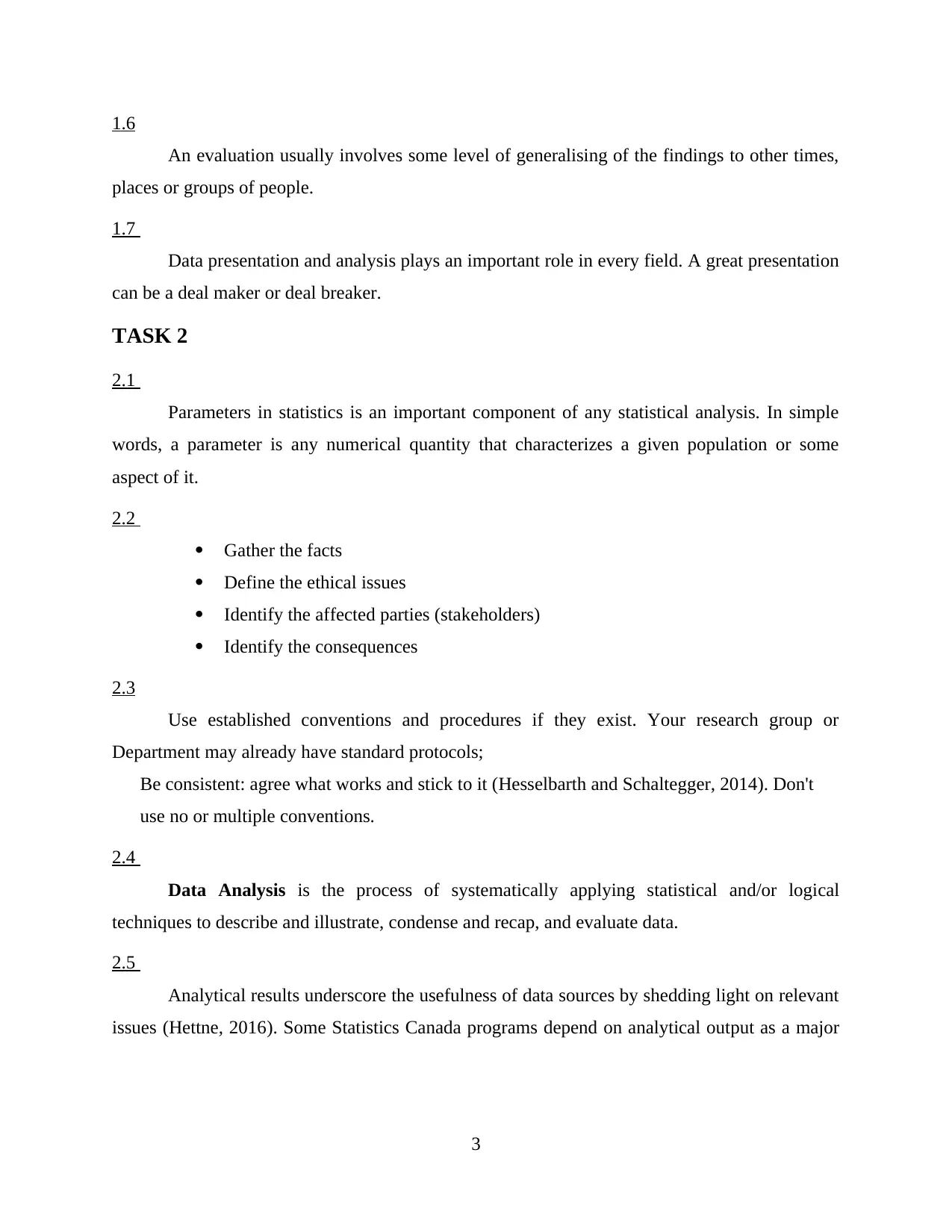
1.6
An evaluation usually involves some level of generalising of the findings to other times,
places or groups of people.
1.7
Data presentation and analysis plays an important role in every field. A great presentation
can be a deal maker or deal breaker.
TASK 2
2.1
Parameters in statistics is an important component of any statistical analysis. In simple
words, a parameter is any numerical quantity that characterizes a given population or some
aspect of it.
2.2
Gather the facts
Define the ethical issues
Identify the affected parties (stakeholders)
Identify the consequences
2.3
Use established conventions and procedures if they exist. Your research group or
Department may already have standard protocols;
Be consistent: agree what works and stick to it (Hesselbarth and Schaltegger, 2014). Don't
use no or multiple conventions.
2.4
Data Analysis is the process of systematically applying statistical and/or logical
techniques to describe and illustrate, condense and recap, and evaluate data.
2.5
Analytical results underscore the usefulness of data sources by shedding light on relevant
issues (Hettne, 2016). Some Statistics Canada programs depend on analytical output as a major
3
An evaluation usually involves some level of generalising of the findings to other times,
places or groups of people.
1.7
Data presentation and analysis plays an important role in every field. A great presentation
can be a deal maker or deal breaker.
TASK 2
2.1
Parameters in statistics is an important component of any statistical analysis. In simple
words, a parameter is any numerical quantity that characterizes a given population or some
aspect of it.
2.2
Gather the facts
Define the ethical issues
Identify the affected parties (stakeholders)
Identify the consequences
2.3
Use established conventions and procedures if they exist. Your research group or
Department may already have standard protocols;
Be consistent: agree what works and stick to it (Hesselbarth and Schaltegger, 2014). Don't
use no or multiple conventions.
2.4
Data Analysis is the process of systematically applying statistical and/or logical
techniques to describe and illustrate, condense and recap, and evaluate data.
2.5
Analytical results underscore the usefulness of data sources by shedding light on relevant
issues (Hettne, 2016). Some Statistics Canada programs depend on analytical output as a major
3
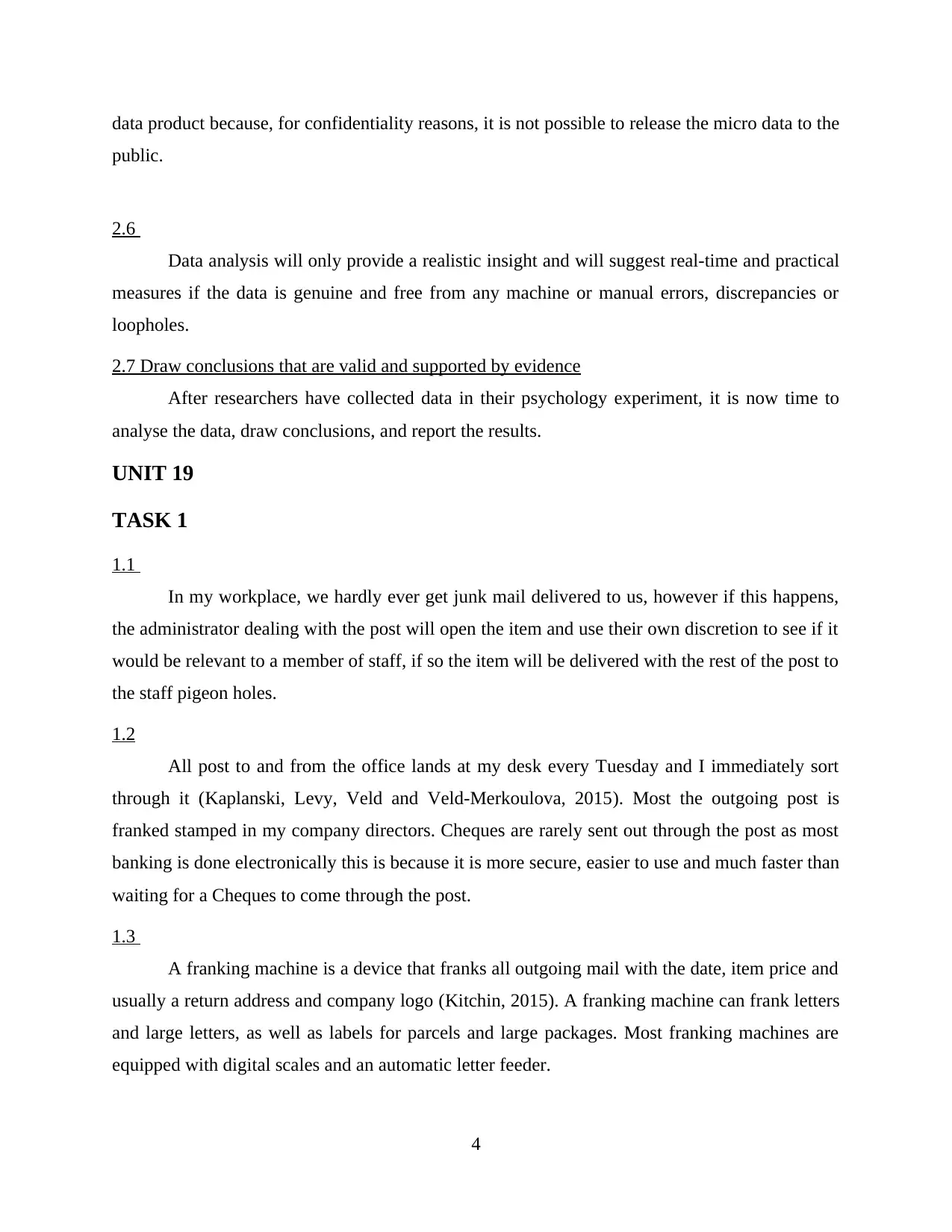
data product because, for confidentiality reasons, it is not possible to release the micro data to the
public.
2.6
Data analysis will only provide a realistic insight and will suggest real-time and practical
measures if the data is genuine and free from any machine or manual errors, discrepancies or
loopholes.
2.7 Draw conclusions that are valid and supported by evidence
After researchers have collected data in their psychology experiment, it is now time to
analyse the data, draw conclusions, and report the results.
UNIT 19
TASK 1
1.1
In my workplace, we hardly ever get junk mail delivered to us, however if this happens,
the administrator dealing with the post will open the item and use their own discretion to see if it
would be relevant to a member of staff, if so the item will be delivered with the rest of the post to
the staff pigeon holes.
1.2
All post to and from the office lands at my desk every Tuesday and I immediately sort
through it (Kaplanski, Levy, Veld and Veld-Merkoulova, 2015). Most the outgoing post is
franked stamped in my company directors. Cheques are rarely sent out through the post as most
banking is done electronically this is because it is more secure, easier to use and much faster than
waiting for a Cheques to come through the post.
1.3
A franking machine is a device that franks all outgoing mail with the date, item price and
usually a return address and company logo (Kitchin, 2015). A franking machine can frank letters
and large letters, as well as labels for parcels and large packages. Most franking machines are
equipped with digital scales and an automatic letter feeder.
4
public.
2.6
Data analysis will only provide a realistic insight and will suggest real-time and practical
measures if the data is genuine and free from any machine or manual errors, discrepancies or
loopholes.
2.7 Draw conclusions that are valid and supported by evidence
After researchers have collected data in their psychology experiment, it is now time to
analyse the data, draw conclusions, and report the results.
UNIT 19
TASK 1
1.1
In my workplace, we hardly ever get junk mail delivered to us, however if this happens,
the administrator dealing with the post will open the item and use their own discretion to see if it
would be relevant to a member of staff, if so the item will be delivered with the rest of the post to
the staff pigeon holes.
1.2
All post to and from the office lands at my desk every Tuesday and I immediately sort
through it (Kaplanski, Levy, Veld and Veld-Merkoulova, 2015). Most the outgoing post is
franked stamped in my company directors. Cheques are rarely sent out through the post as most
banking is done electronically this is because it is more secure, easier to use and much faster than
waiting for a Cheques to come through the post.
1.3
A franking machine is a device that franks all outgoing mail with the date, item price and
usually a return address and company logo (Kitchin, 2015). A franking machine can frank letters
and large letters, as well as labels for parcels and large packages. Most franking machines are
equipped with digital scales and an automatic letter feeder.
4
Secure Best Marks with AI Grader
Need help grading? Try our AI Grader for instant feedback on your assignments.
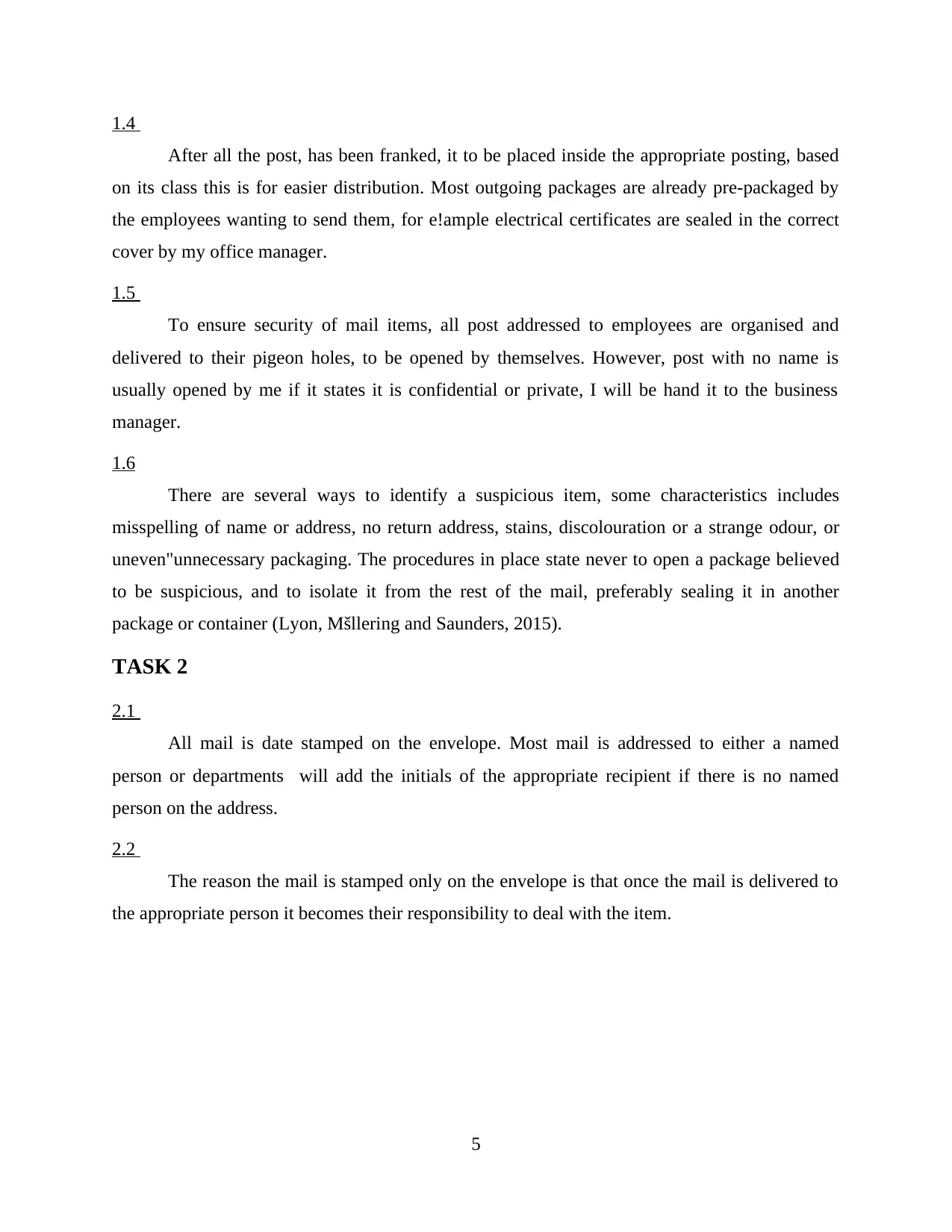
1.4
After all the post, has been franked, it to be placed inside the appropriate posting, based
on its class this is for easier distribution. Most outgoing packages are already pre-packaged by
the employees wanting to send them, for e!ample electrical certificates are sealed in the correct
cover by my office manager.
1.5
To ensure security of mail items, all post addressed to employees are organised and
delivered to their pigeon holes, to be opened by themselves. However, post with no name is
usually opened by me if it states it is confidential or private, I will be hand it to the business
manager.
1.6
There are several ways to identify a suspicious item, some characteristics includes
misspelling of name or address, no return address, stains, discolouration or a strange odour, or
uneven"unnecessary packaging. The procedures in place state never to open a package believed
to be suspicious, and to isolate it from the rest of the mail, preferably sealing it in another
package or container (Lyon, Mšllering and Saunders, 2015).
TASK 2
2.1
All mail is date stamped on the envelope. Most mail is addressed to either a named
person or departments will add the initials of the appropriate recipient if there is no named
person on the address.
2.2
The reason the mail is stamped only on the envelope is that once the mail is delivered to
the appropriate person it becomes their responsibility to deal with the item.
5
After all the post, has been franked, it to be placed inside the appropriate posting, based
on its class this is for easier distribution. Most outgoing packages are already pre-packaged by
the employees wanting to send them, for e!ample electrical certificates are sealed in the correct
cover by my office manager.
1.5
To ensure security of mail items, all post addressed to employees are organised and
delivered to their pigeon holes, to be opened by themselves. However, post with no name is
usually opened by me if it states it is confidential or private, I will be hand it to the business
manager.
1.6
There are several ways to identify a suspicious item, some characteristics includes
misspelling of name or address, no return address, stains, discolouration or a strange odour, or
uneven"unnecessary packaging. The procedures in place state never to open a package believed
to be suspicious, and to isolate it from the rest of the mail, preferably sealing it in another
package or container (Lyon, Mšllering and Saunders, 2015).
TASK 2
2.1
All mail is date stamped on the envelope. Most mail is addressed to either a named
person or departments will add the initials of the appropriate recipient if there is no named
person on the address.
2.2
The reason the mail is stamped only on the envelope is that once the mail is delivered to
the appropriate person it becomes their responsibility to deal with the item.
5
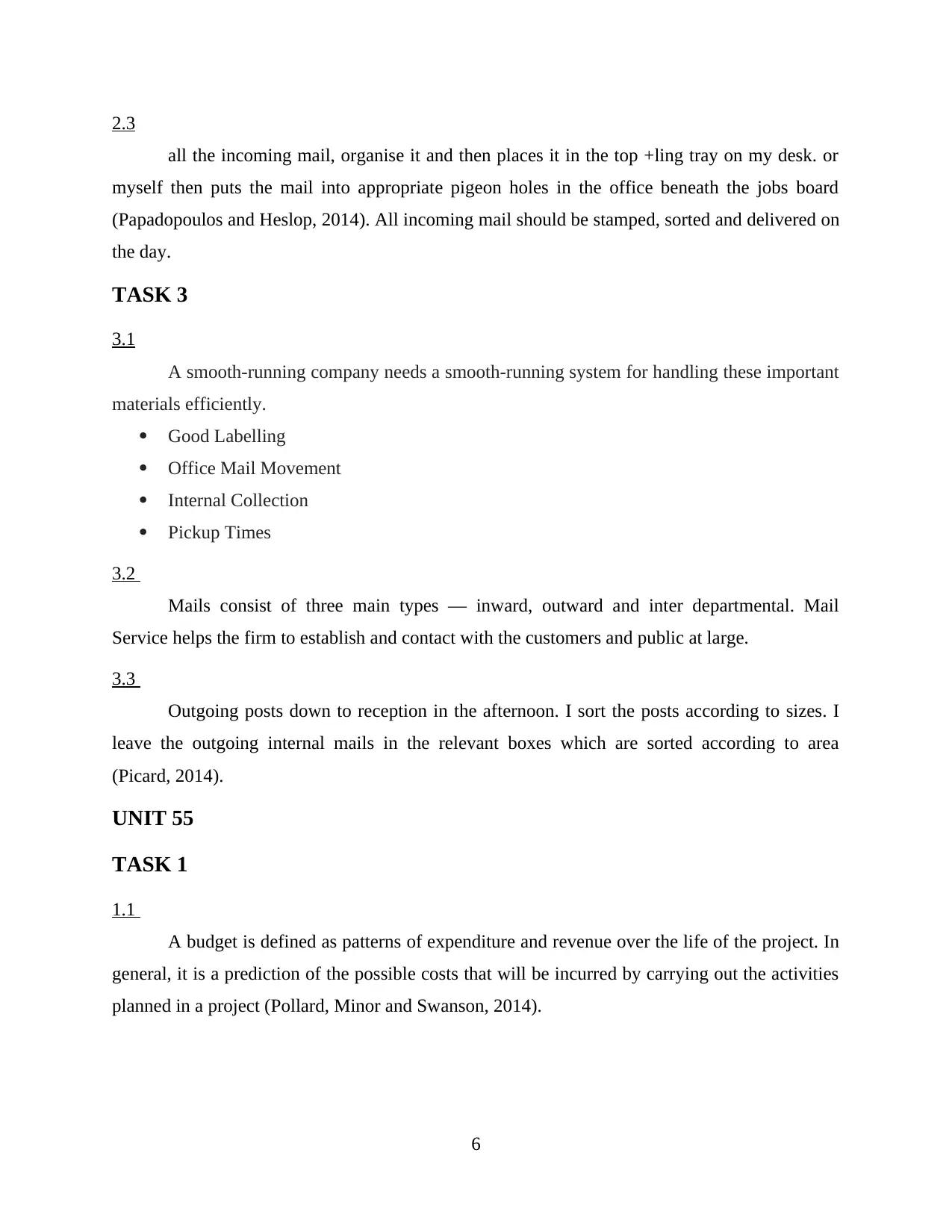
2.3
all the incoming mail, organise it and then places it in the top +ling tray on my desk. or
myself then puts the mail into appropriate pigeon holes in the office beneath the jobs board
(Papadopoulos and Heslop, 2014). All incoming mail should be stamped, sorted and delivered on
the day.
TASK 3
3.1
A smooth-running company needs a smooth-running system for handling these important
materials efficiently.
Good Labelling
Office Mail Movement
Internal Collection
Pickup Times
3.2
Mails consist of three main types — inward, outward and inter departmental. Mail
Service helps the firm to establish and contact with the customers and public at large.
3.3
Outgoing posts down to reception in the afternoon. I sort the posts according to sizes. I
leave the outgoing internal mails in the relevant boxes which are sorted according to area
(Picard, 2014).
UNIT 55
TASK 1
1.1
A budget is defined as patterns of expenditure and revenue over the life of the project. In
general, it is a prediction of the possible costs that will be incurred by carrying out the activities
planned in a project (Pollard, Minor and Swanson, 2014).
6
all the incoming mail, organise it and then places it in the top +ling tray on my desk. or
myself then puts the mail into appropriate pigeon holes in the office beneath the jobs board
(Papadopoulos and Heslop, 2014). All incoming mail should be stamped, sorted and delivered on
the day.
TASK 3
3.1
A smooth-running company needs a smooth-running system for handling these important
materials efficiently.
Good Labelling
Office Mail Movement
Internal Collection
Pickup Times
3.2
Mails consist of three main types — inward, outward and inter departmental. Mail
Service helps the firm to establish and contact with the customers and public at large.
3.3
Outgoing posts down to reception in the afternoon. I sort the posts according to sizes. I
leave the outgoing internal mails in the relevant boxes which are sorted according to area
(Picard, 2014).
UNIT 55
TASK 1
1.1
A budget is defined as patterns of expenditure and revenue over the life of the project. In
general, it is a prediction of the possible costs that will be incurred by carrying out the activities
planned in a project (Pollard, Minor and Swanson, 2014).
6
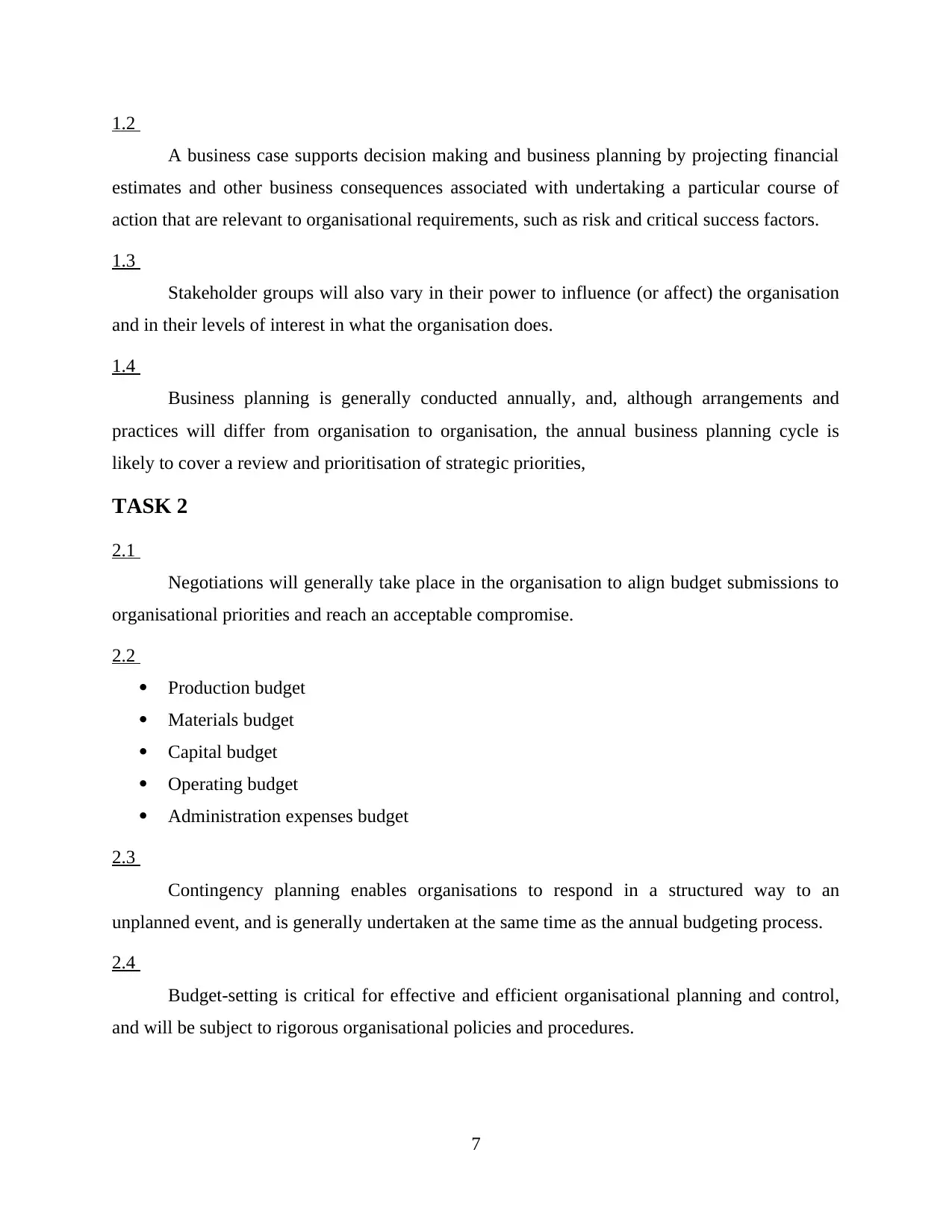
1.2
A business case supports decision making and business planning by projecting financial
estimates and other business consequences associated with undertaking a particular course of
action that are relevant to organisational requirements, such as risk and critical success factors.
1.3
Stakeholder groups will also vary in their power to influence (or affect) the organisation
and in their levels of interest in what the organisation does.
1.4
Business planning is generally conducted annually, and, although arrangements and
practices will differ from organisation to organisation, the annual business planning cycle is
likely to cover a review and prioritisation of strategic priorities,
TASK 2
2.1
Negotiations will generally take place in the organisation to align budget submissions to
organisational priorities and reach an acceptable compromise.
2.2
Production budget
Materials budget
Capital budget
Operating budget
Administration expenses budget
2.3
Contingency planning enables organisations to respond in a structured way to an
unplanned event, and is generally undertaken at the same time as the annual budgeting process.
2.4
Budget-setting is critical for effective and efficient organisational planning and control,
and will be subject to rigorous organisational policies and procedures.
7
A business case supports decision making and business planning by projecting financial
estimates and other business consequences associated with undertaking a particular course of
action that are relevant to organisational requirements, such as risk and critical success factors.
1.3
Stakeholder groups will also vary in their power to influence (or affect) the organisation
and in their levels of interest in what the organisation does.
1.4
Business planning is generally conducted annually, and, although arrangements and
practices will differ from organisation to organisation, the annual business planning cycle is
likely to cover a review and prioritisation of strategic priorities,
TASK 2
2.1
Negotiations will generally take place in the organisation to align budget submissions to
organisational priorities and reach an acceptable compromise.
2.2
Production budget
Materials budget
Capital budget
Operating budget
Administration expenses budget
2.3
Contingency planning enables organisations to respond in a structured way to an
unplanned event, and is generally undertaken at the same time as the annual budgeting process.
2.4
Budget-setting is critical for effective and efficient organisational planning and control,
and will be subject to rigorous organisational policies and procedures.
7
Paraphrase This Document
Need a fresh take? Get an instant paraphrase of this document with our AI Paraphraser
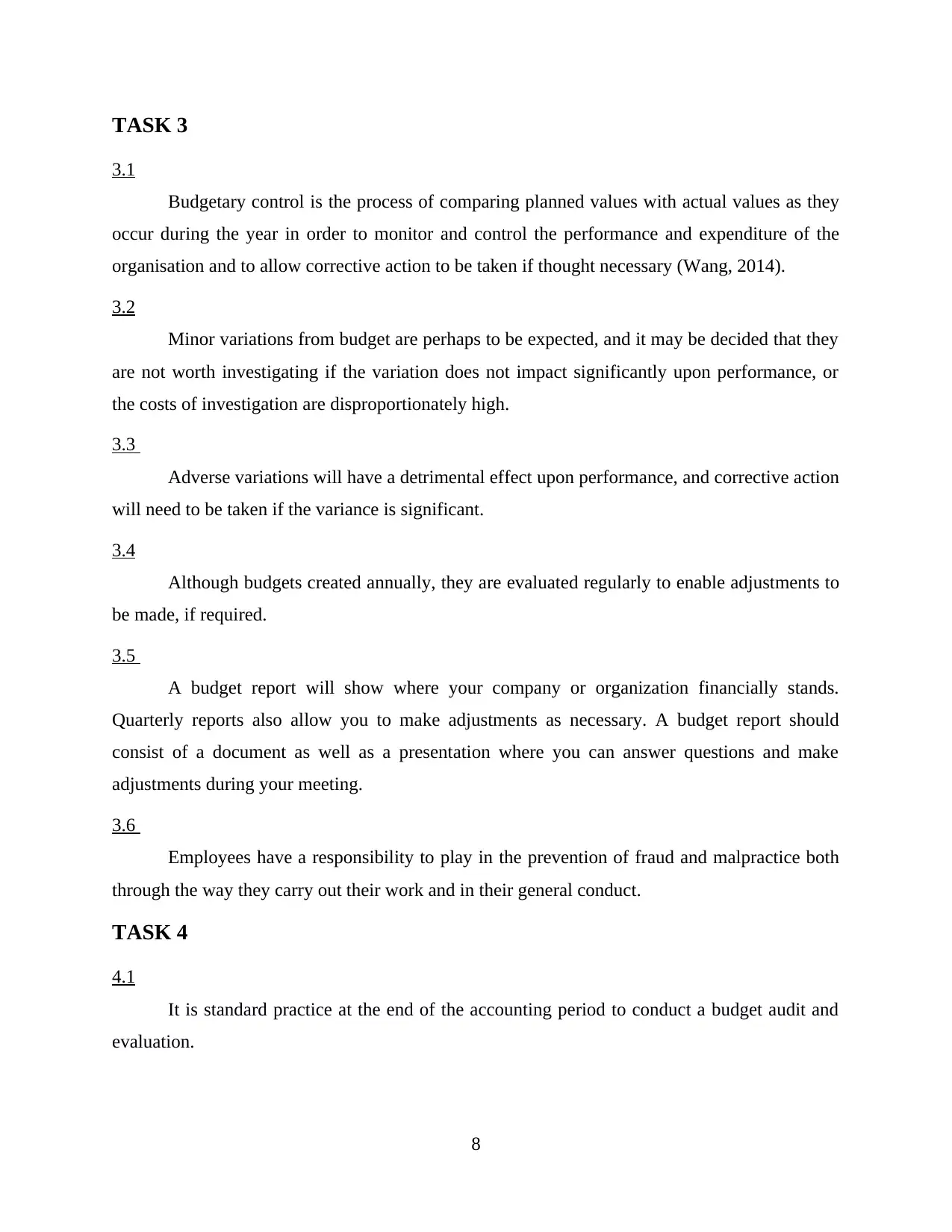
TASK 3
3.1
Budgetary control is the process of comparing planned values with actual values as they
occur during the year in order to monitor and control the performance and expenditure of the
organisation and to allow corrective action to be taken if thought necessary (Wang, 2014).
3.2
Minor variations from budget are perhaps to be expected, and it may be decided that they
are not worth investigating if the variation does not impact significantly upon performance, or
the costs of investigation are disproportionately high.
3.3
Adverse variations will have a detrimental effect upon performance, and corrective action
will need to be taken if the variance is significant.
3.4
Although budgets created annually, they are evaluated regularly to enable adjustments to
be made, if required.
3.5
A budget report will show where your company or organization financially stands.
Quarterly reports also allow you to make adjustments as necessary. A budget report should
consist of a document as well as a presentation where you can answer questions and make
adjustments during your meeting.
3.6
Employees have a responsibility to play in the prevention of fraud and malpractice both
through the way they carry out their work and in their general conduct.
TASK 4
4.1
It is standard practice at the end of the accounting period to conduct a budget audit and
evaluation.
8
3.1
Budgetary control is the process of comparing planned values with actual values as they
occur during the year in order to monitor and control the performance and expenditure of the
organisation and to allow corrective action to be taken if thought necessary (Wang, 2014).
3.2
Minor variations from budget are perhaps to be expected, and it may be decided that they
are not worth investigating if the variation does not impact significantly upon performance, or
the costs of investigation are disproportionately high.
3.3
Adverse variations will have a detrimental effect upon performance, and corrective action
will need to be taken if the variance is significant.
3.4
Although budgets created annually, they are evaluated regularly to enable adjustments to
be made, if required.
3.5
A budget report will show where your company or organization financially stands.
Quarterly reports also allow you to make adjustments as necessary. A budget report should
consist of a document as well as a presentation where you can answer questions and make
adjustments during your meeting.
3.6
Employees have a responsibility to play in the prevention of fraud and malpractice both
through the way they carry out their work and in their general conduct.
TASK 4
4.1
It is standard practice at the end of the accounting period to conduct a budget audit and
evaluation.
8
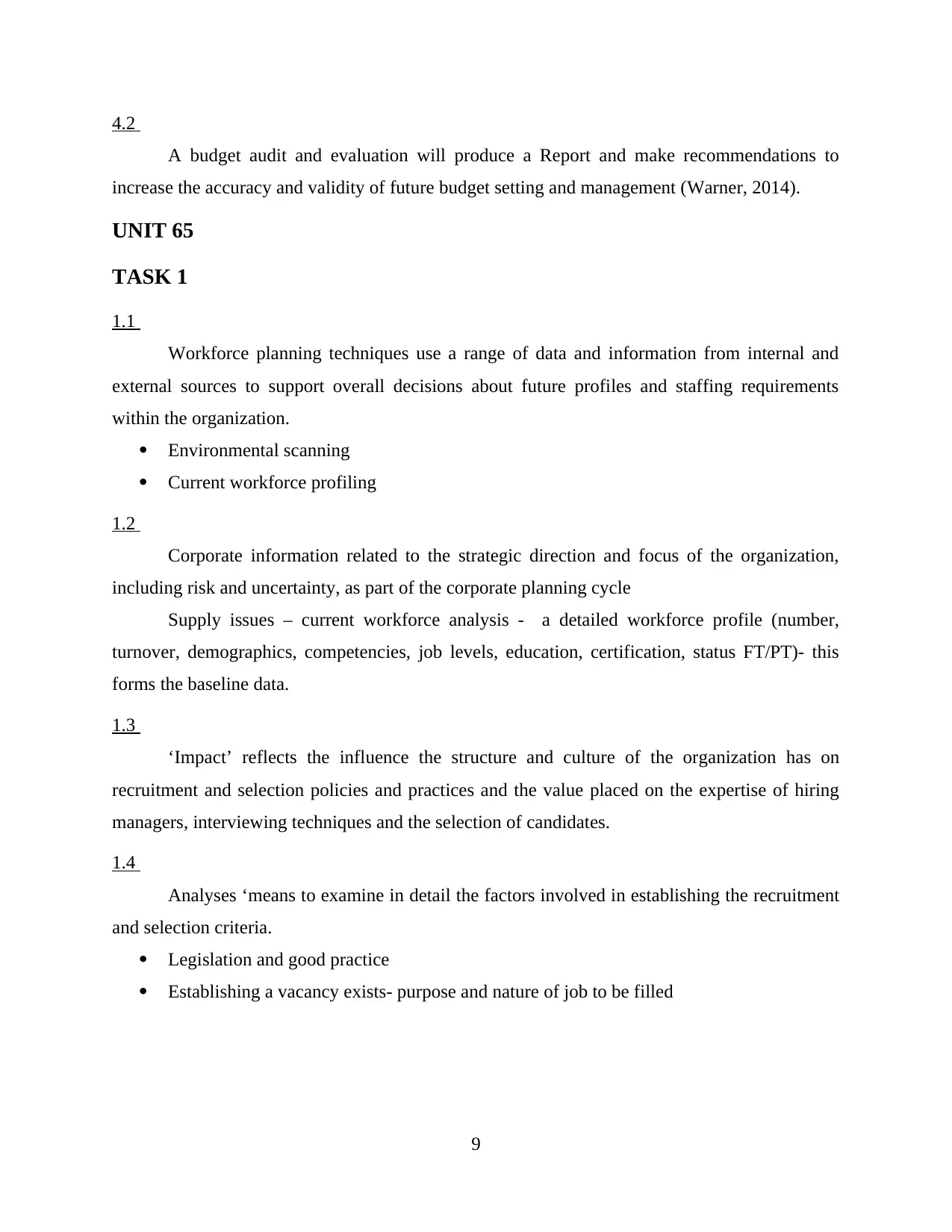
4.2
A budget audit and evaluation will produce a Report and make recommendations to
increase the accuracy and validity of future budget setting and management (Warner, 2014).
UNIT 65
TASK 1
1.1
Workforce planning techniques use a range of data and information from internal and
external sources to support overall decisions about future profiles and staffing requirements
within the organization.
Environmental scanning
Current workforce profiling
1.2
Corporate information related to the strategic direction and focus of the organization,
including risk and uncertainty, as part of the corporate planning cycle
Supply issues – current workforce analysis - a detailed workforce profile (number,
turnover, demographics, competencies, job levels, education, certification, status FT/PT)- this
forms the baseline data.
1.3
‘Impact’ reflects the influence the structure and culture of the organization has on
recruitment and selection policies and practices and the value placed on the expertise of hiring
managers, interviewing techniques and the selection of candidates.
1.4
Analyses ‘means to examine in detail the factors involved in establishing the recruitment
and selection criteria.
Legislation and good practice
Establishing a vacancy exists- purpose and nature of job to be filled
9
A budget audit and evaluation will produce a Report and make recommendations to
increase the accuracy and validity of future budget setting and management (Warner, 2014).
UNIT 65
TASK 1
1.1
Workforce planning techniques use a range of data and information from internal and
external sources to support overall decisions about future profiles and staffing requirements
within the organization.
Environmental scanning
Current workforce profiling
1.2
Corporate information related to the strategic direction and focus of the organization,
including risk and uncertainty, as part of the corporate planning cycle
Supply issues – current workforce analysis - a detailed workforce profile (number,
turnover, demographics, competencies, job levels, education, certification, status FT/PT)- this
forms the baseline data.
1.3
‘Impact’ reflects the influence the structure and culture of the organization has on
recruitment and selection policies and practices and the value placed on the expertise of hiring
managers, interviewing techniques and the selection of candidates.
1.4
Analyses ‘means to examine in detail the factors involved in establishing the recruitment
and selection criteria.
Legislation and good practice
Establishing a vacancy exists- purpose and nature of job to be filled
9
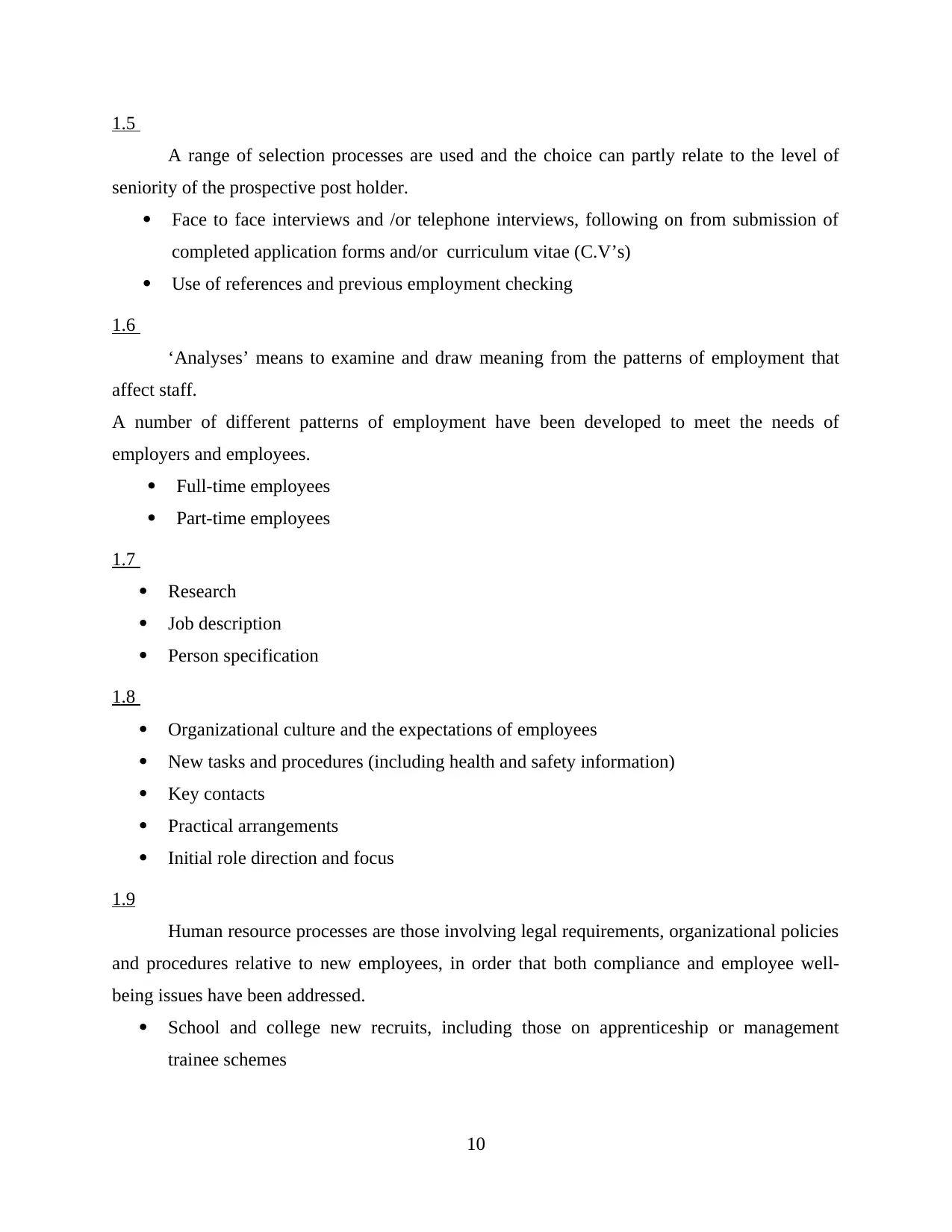
1.5
A range of selection processes are used and the choice can partly relate to the level of
seniority of the prospective post holder.
Face to face interviews and /or telephone interviews, following on from submission of
completed application forms and/or curriculum vitae (C.V’s)
Use of references and previous employment checking
1.6
‘Analyses’ means to examine and draw meaning from the patterns of employment that
affect staff.
A number of different patterns of employment have been developed to meet the needs of
employers and employees.
Full-time employees
Part-time employees
1.7
Research
Job description
Person specification
1.8
Organizational culture and the expectations of employees
New tasks and procedures (including health and safety information)
Key contacts
Practical arrangements
Initial role direction and focus
1.9
Human resource processes are those involving legal requirements, organizational policies
and procedures relative to new employees, in order that both compliance and employee well-
being issues have been addressed.
School and college new recruits, including those on apprenticeship or management
trainee schemes
10
A range of selection processes are used and the choice can partly relate to the level of
seniority of the prospective post holder.
Face to face interviews and /or telephone interviews, following on from submission of
completed application forms and/or curriculum vitae (C.V’s)
Use of references and previous employment checking
1.6
‘Analyses’ means to examine and draw meaning from the patterns of employment that
affect staff.
A number of different patterns of employment have been developed to meet the needs of
employers and employees.
Full-time employees
Part-time employees
1.7
Research
Job description
Person specification
1.8
Organizational culture and the expectations of employees
New tasks and procedures (including health and safety information)
Key contacts
Practical arrangements
Initial role direction and focus
1.9
Human resource processes are those involving legal requirements, organizational policies
and procedures relative to new employees, in order that both compliance and employee well-
being issues have been addressed.
School and college new recruits, including those on apprenticeship or management
trainee schemes
10
Secure Best Marks with AI Grader
Need help grading? Try our AI Grader for instant feedback on your assignments.
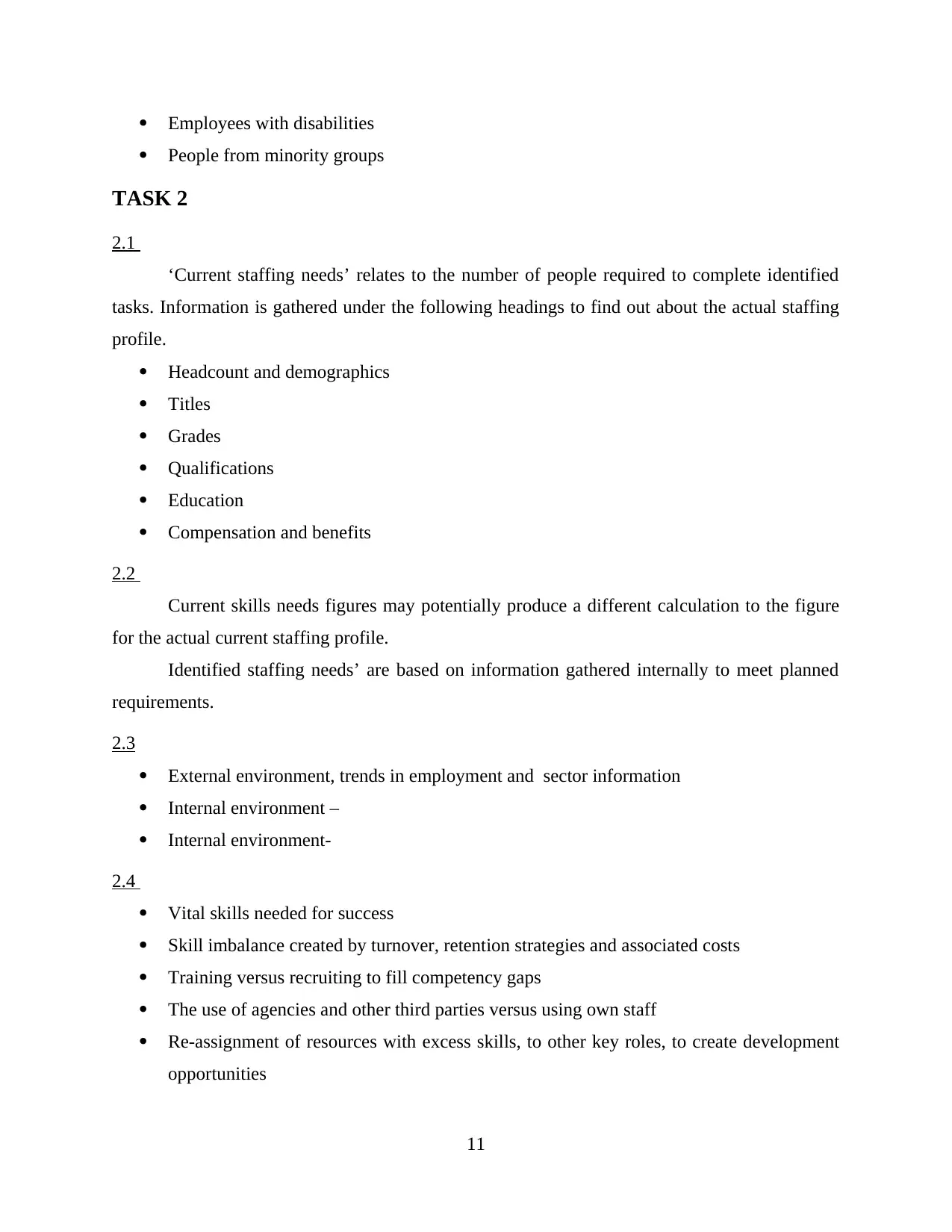
Employees with disabilities
People from minority groups
TASK 2
2.1
‘Current staffing needs’ relates to the number of people required to complete identified
tasks. Information is gathered under the following headings to find out about the actual staffing
profile.
Headcount and demographics
Titles
Grades
Qualifications
Education
Compensation and benefits
2.2
Current skills needs figures may potentially produce a different calculation to the figure
for the actual current staffing profile.
Identified staffing needs’ are based on information gathered internally to meet planned
requirements.
2.3
External environment, trends in employment and sector information
Internal environment –
Internal environment-
2.4
Vital skills needed for success
Skill imbalance created by turnover, retention strategies and associated costs
Training versus recruiting to fill competency gaps
The use of agencies and other third parties versus using own staff
Re-assignment of resources with excess skills, to other key roles, to create development
opportunities
11
People from minority groups
TASK 2
2.1
‘Current staffing needs’ relates to the number of people required to complete identified
tasks. Information is gathered under the following headings to find out about the actual staffing
profile.
Headcount and demographics
Titles
Grades
Qualifications
Education
Compensation and benefits
2.2
Current skills needs figures may potentially produce a different calculation to the figure
for the actual current staffing profile.
Identified staffing needs’ are based on information gathered internally to meet planned
requirements.
2.3
External environment, trends in employment and sector information
Internal environment –
Internal environment-
2.4
Vital skills needed for success
Skill imbalance created by turnover, retention strategies and associated costs
Training versus recruiting to fill competency gaps
The use of agencies and other third parties versus using own staff
Re-assignment of resources with excess skills, to other key roles, to create development
opportunities
11
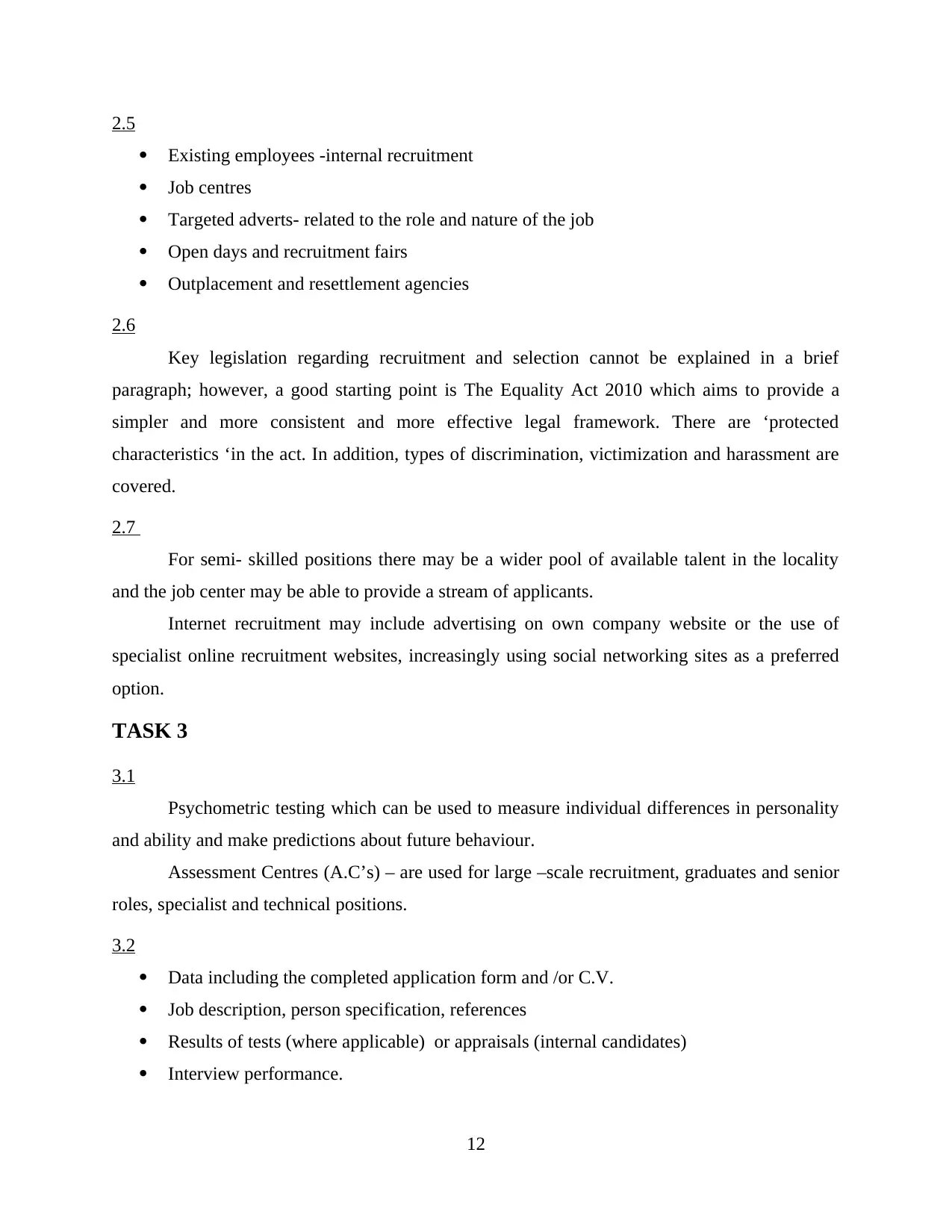
2.5
Existing employees -internal recruitment
Job centres
Targeted adverts- related to the role and nature of the job
Open days and recruitment fairs
Outplacement and resettlement agencies
2.6
Key legislation regarding recruitment and selection cannot be explained in a brief
paragraph; however, a good starting point is The Equality Act 2010 which aims to provide a
simpler and more consistent and more effective legal framework. There are ‘protected
characteristics ‘in the act. In addition, types of discrimination, victimization and harassment are
covered.
2.7
For semi- skilled positions there may be a wider pool of available talent in the locality
and the job center may be able to provide a stream of applicants.
Internet recruitment may include advertising on own company website or the use of
specialist online recruitment websites, increasingly using social networking sites as a preferred
option.
TASK 3
3.1
Psychometric testing which can be used to measure individual differences in personality
and ability and make predictions about future behaviour.
Assessment Centres (A.C’s) – are used for large –scale recruitment, graduates and senior
roles, specialist and technical positions.
3.2
Data including the completed application form and /or C.V.
Job description, person specification, references
Results of tests (where applicable) or appraisals (internal candidates)
Interview performance.
12
Existing employees -internal recruitment
Job centres
Targeted adverts- related to the role and nature of the job
Open days and recruitment fairs
Outplacement and resettlement agencies
2.6
Key legislation regarding recruitment and selection cannot be explained in a brief
paragraph; however, a good starting point is The Equality Act 2010 which aims to provide a
simpler and more consistent and more effective legal framework. There are ‘protected
characteristics ‘in the act. In addition, types of discrimination, victimization and harassment are
covered.
2.7
For semi- skilled positions there may be a wider pool of available talent in the locality
and the job center may be able to provide a stream of applicants.
Internet recruitment may include advertising on own company website or the use of
specialist online recruitment websites, increasingly using social networking sites as a preferred
option.
TASK 3
3.1
Psychometric testing which can be used to measure individual differences in personality
and ability and make predictions about future behaviour.
Assessment Centres (A.C’s) – are used for large –scale recruitment, graduates and senior
roles, specialist and technical positions.
3.2
Data including the completed application form and /or C.V.
Job description, person specification, references
Results of tests (where applicable) or appraisals (internal candidates)
Interview performance.
12
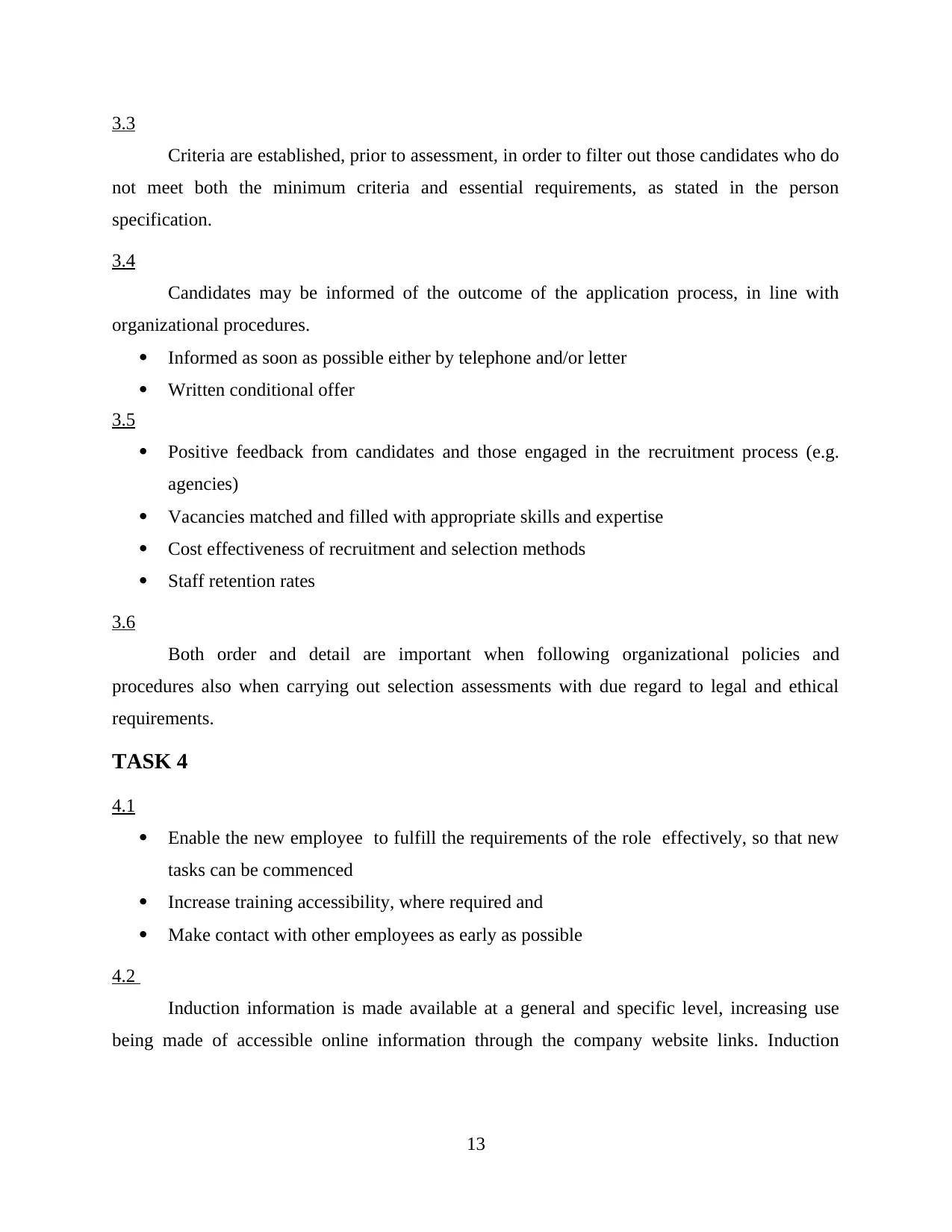
3.3
Criteria are established, prior to assessment, in order to filter out those candidates who do
not meet both the minimum criteria and essential requirements, as stated in the person
specification.
3.4
Candidates may be informed of the outcome of the application process, in line with
organizational procedures.
Informed as soon as possible either by telephone and/or letter
Written conditional offer
3.5
Positive feedback from candidates and those engaged in the recruitment process (e.g.
agencies)
Vacancies matched and filled with appropriate skills and expertise
Cost effectiveness of recruitment and selection methods
Staff retention rates
3.6
Both order and detail are important when following organizational policies and
procedures also when carrying out selection assessments with due regard to legal and ethical
requirements.
TASK 4
4.1
Enable the new employee to fulfill the requirements of the role effectively, so that new
tasks can be commenced
Increase training accessibility, where required and
Make contact with other employees as early as possible
4.2
Induction information is made available at a general and specific level, increasing use
being made of accessible online information through the company website links. Induction
13
Criteria are established, prior to assessment, in order to filter out those candidates who do
not meet both the minimum criteria and essential requirements, as stated in the person
specification.
3.4
Candidates may be informed of the outcome of the application process, in line with
organizational procedures.
Informed as soon as possible either by telephone and/or letter
Written conditional offer
3.5
Positive feedback from candidates and those engaged in the recruitment process (e.g.
agencies)
Vacancies matched and filled with appropriate skills and expertise
Cost effectiveness of recruitment and selection methods
Staff retention rates
3.6
Both order and detail are important when following organizational policies and
procedures also when carrying out selection assessments with due regard to legal and ethical
requirements.
TASK 4
4.1
Enable the new employee to fulfill the requirements of the role effectively, so that new
tasks can be commenced
Increase training accessibility, where required and
Make contact with other employees as early as possible
4.2
Induction information is made available at a general and specific level, increasing use
being made of accessible online information through the company website links. Induction
13
Paraphrase This Document
Need a fresh take? Get an instant paraphrase of this document with our AI Paraphraser
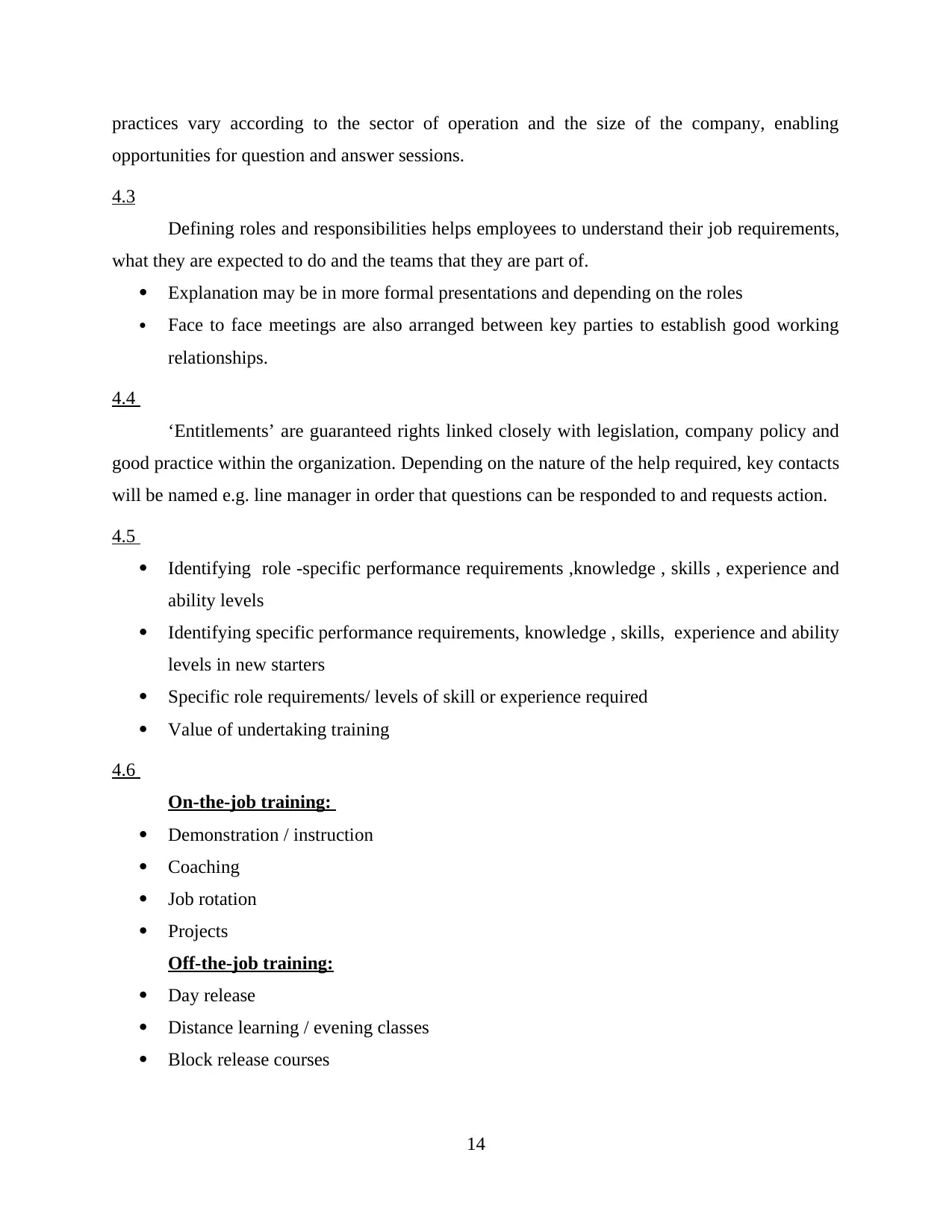
practices vary according to the sector of operation and the size of the company, enabling
opportunities for question and answer sessions.
4.3
Defining roles and responsibilities helps employees to understand their job requirements,
what they are expected to do and the teams that they are part of.
Explanation may be in more formal presentations and depending on the roles
Face to face meetings are also arranged between key parties to establish good working
relationships.
4.4
‘Entitlements’ are guaranteed rights linked closely with legislation, company policy and
good practice within the organization. Depending on the nature of the help required, key contacts
will be named e.g. line manager in order that questions can be responded to and requests action.
4.5
Identifying role -specific performance requirements ,knowledge , skills , experience and
ability levels
Identifying specific performance requirements, knowledge , skills, experience and ability
levels in new starters
Specific role requirements/ levels of skill or experience required
Value of undertaking training
4.6
On-the-job training:
Demonstration / instruction
Coaching
Job rotation
Projects
Off-the-job training:
Day release
Distance learning / evening classes
Block release courses
14
opportunities for question and answer sessions.
4.3
Defining roles and responsibilities helps employees to understand their job requirements,
what they are expected to do and the teams that they are part of.
Explanation may be in more formal presentations and depending on the roles
Face to face meetings are also arranged between key parties to establish good working
relationships.
4.4
‘Entitlements’ are guaranteed rights linked closely with legislation, company policy and
good practice within the organization. Depending on the nature of the help required, key contacts
will be named e.g. line manager in order that questions can be responded to and requests action.
4.5
Identifying role -specific performance requirements ,knowledge , skills , experience and
ability levels
Identifying specific performance requirements, knowledge , skills, experience and ability
levels in new starters
Specific role requirements/ levels of skill or experience required
Value of undertaking training
4.6
On-the-job training:
Demonstration / instruction
Coaching
Job rotation
Projects
Off-the-job training:
Day release
Distance learning / evening classes
Block release courses
14
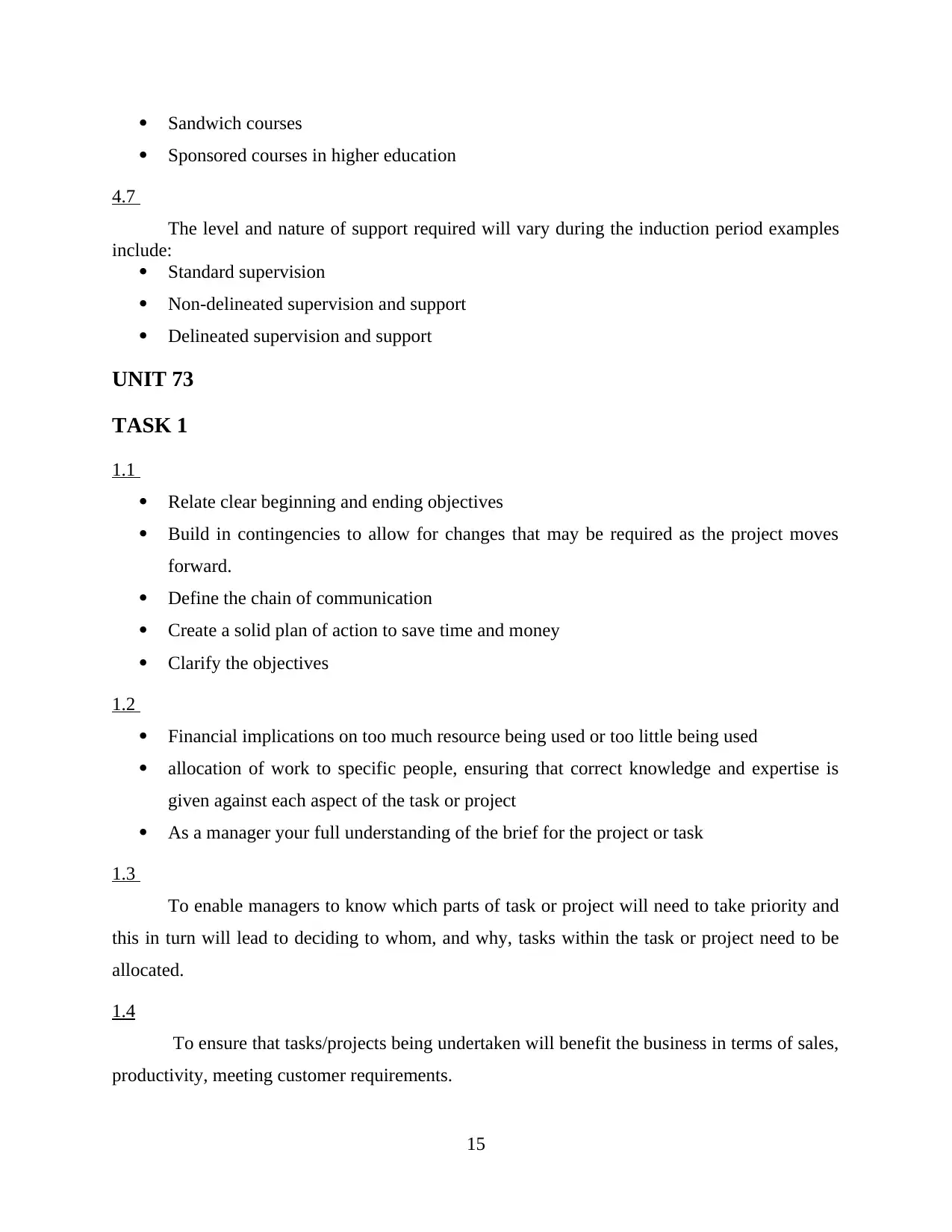
Sandwich courses
Sponsored courses in higher education
4.7
The level and nature of support required will vary during the induction period examples
include:
Standard supervision
Non-delineated supervision and support
Delineated supervision and support
UNIT 73
TASK 1
1.1
Relate clear beginning and ending objectives
Build in contingencies to allow for changes that may be required as the project moves
forward.
Define the chain of communication
Create a solid plan of action to save time and money
Clarify the objectives
1.2
Financial implications on too much resource being used or too little being used
allocation of work to specific people, ensuring that correct knowledge and expertise is
given against each aspect of the task or project
As a manager your full understanding of the brief for the project or task
1.3
To enable managers to know which parts of task or project will need to take priority and
this in turn will lead to deciding to whom, and why, tasks within the task or project need to be
allocated.
1.4
To ensure that tasks/projects being undertaken will benefit the business in terms of sales,
productivity, meeting customer requirements.
15
Sponsored courses in higher education
4.7
The level and nature of support required will vary during the induction period examples
include:
Standard supervision
Non-delineated supervision and support
Delineated supervision and support
UNIT 73
TASK 1
1.1
Relate clear beginning and ending objectives
Build in contingencies to allow for changes that may be required as the project moves
forward.
Define the chain of communication
Create a solid plan of action to save time and money
Clarify the objectives
1.2
Financial implications on too much resource being used or too little being used
allocation of work to specific people, ensuring that correct knowledge and expertise is
given against each aspect of the task or project
As a manager your full understanding of the brief for the project or task
1.3
To enable managers to know which parts of task or project will need to take priority and
this in turn will lead to deciding to whom, and why, tasks within the task or project need to be
allocated.
1.4
To ensure that tasks/projects being undertaken will benefit the business in terms of sales,
productivity, meeting customer requirements.
15
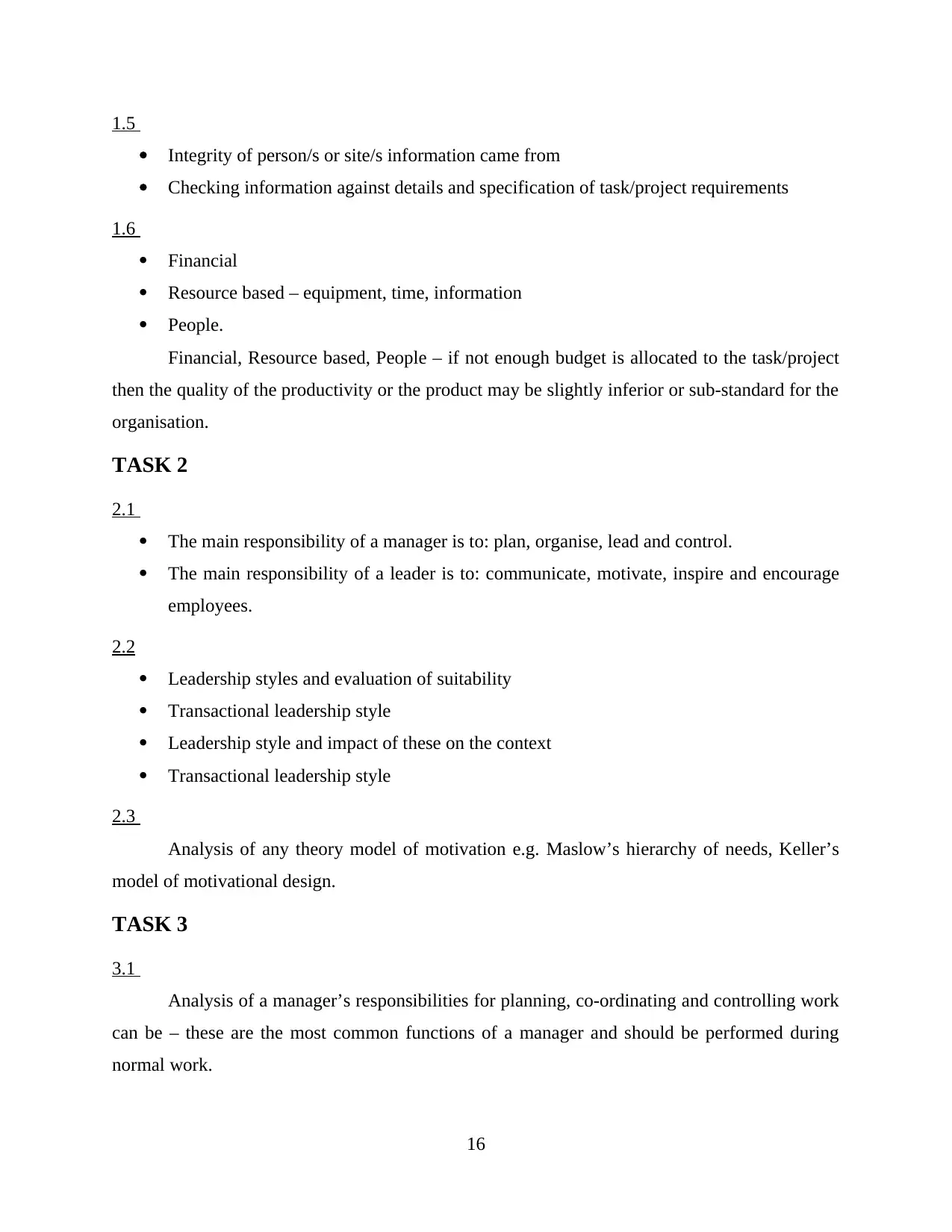
1.5
Integrity of person/s or site/s information came from
Checking information against details and specification of task/project requirements
1.6
Financial
Resource based – equipment, time, information
People.
Financial, Resource based, People – if not enough budget is allocated to the task/project
then the quality of the productivity or the product may be slightly inferior or sub-standard for the
organisation.
TASK 2
2.1
The main responsibility of a manager is to: plan, organise, lead and control.
The main responsibility of a leader is to: communicate, motivate, inspire and encourage
employees.
2.2
Leadership styles and evaluation of suitability
Transactional leadership style
Leadership style and impact of these on the context
Transactional leadership style
2.3
Analysis of any theory model of motivation e.g. Maslow’s hierarchy of needs, Keller’s
model of motivational design.
TASK 3
3.1
Analysis of a manager’s responsibilities for planning, co-ordinating and controlling work
can be – these are the most common functions of a manager and should be performed during
normal work.
16
Integrity of person/s or site/s information came from
Checking information against details and specification of task/project requirements
1.6
Financial
Resource based – equipment, time, information
People.
Financial, Resource based, People – if not enough budget is allocated to the task/project
then the quality of the productivity or the product may be slightly inferior or sub-standard for the
organisation.
TASK 2
2.1
The main responsibility of a manager is to: plan, organise, lead and control.
The main responsibility of a leader is to: communicate, motivate, inspire and encourage
employees.
2.2
Leadership styles and evaluation of suitability
Transactional leadership style
Leadership style and impact of these on the context
Transactional leadership style
2.3
Analysis of any theory model of motivation e.g. Maslow’s hierarchy of needs, Keller’s
model of motivational design.
TASK 3
3.1
Analysis of a manager’s responsibilities for planning, co-ordinating and controlling work
can be – these are the most common functions of a manager and should be performed during
normal work.
16
Secure Best Marks with AI Grader
Need help grading? Try our AI Grader for instant feedback on your assignments.

3.2
Consider smart targeting for all team members, close monitoring of progress of
individuals and overall team objective, building commitment from the team and each person in
the team, being clear about objectives.
3.3
This is effectively the personality of an organisation; if the organisation has clear vision,
mission and objectives then the manager knows the culture he/ she is working within and
achievements made can be set against these parameters.
3.4
Nudge theory
Corporate governance
Tuckman’s forming, storming, norming and performing model
3.5
Information and explanations on how directive a manager will need to be dependent on
the theory used, how hands on a manager needs to be with managing different aspects of team
behaviours, thinking processes and motivations and commitments.
3.6
• Staffing levels – increased or decreased
• Allocation and procurement of resources and materials
TASK 4
4.1
The objectives are set first and within this key criteria of outcomes are set also. These
outcomes against each aspect of the performance indicators then feeds back into the organisation
overall objectives.
4.2
The main / key features are that it has to be reliable and good. The performance system
could include – information needs to be quantitative, measurable, easily understood by everyone
17
Consider smart targeting for all team members, close monitoring of progress of
individuals and overall team objective, building commitment from the team and each person in
the team, being clear about objectives.
3.3
This is effectively the personality of an organisation; if the organisation has clear vision,
mission and objectives then the manager knows the culture he/ she is working within and
achievements made can be set against these parameters.
3.4
Nudge theory
Corporate governance
Tuckman’s forming, storming, norming and performing model
3.5
Information and explanations on how directive a manager will need to be dependent on
the theory used, how hands on a manager needs to be with managing different aspects of team
behaviours, thinking processes and motivations and commitments.
3.6
• Staffing levels – increased or decreased
• Allocation and procurement of resources and materials
TASK 4
4.1
The objectives are set first and within this key criteria of outcomes are set also. These
outcomes against each aspect of the performance indicators then feeds back into the organisation
overall objectives.
4.2
The main / key features are that it has to be reliable and good. The performance system
could include – information needs to be quantitative, measurable, easily understood by everyone
17
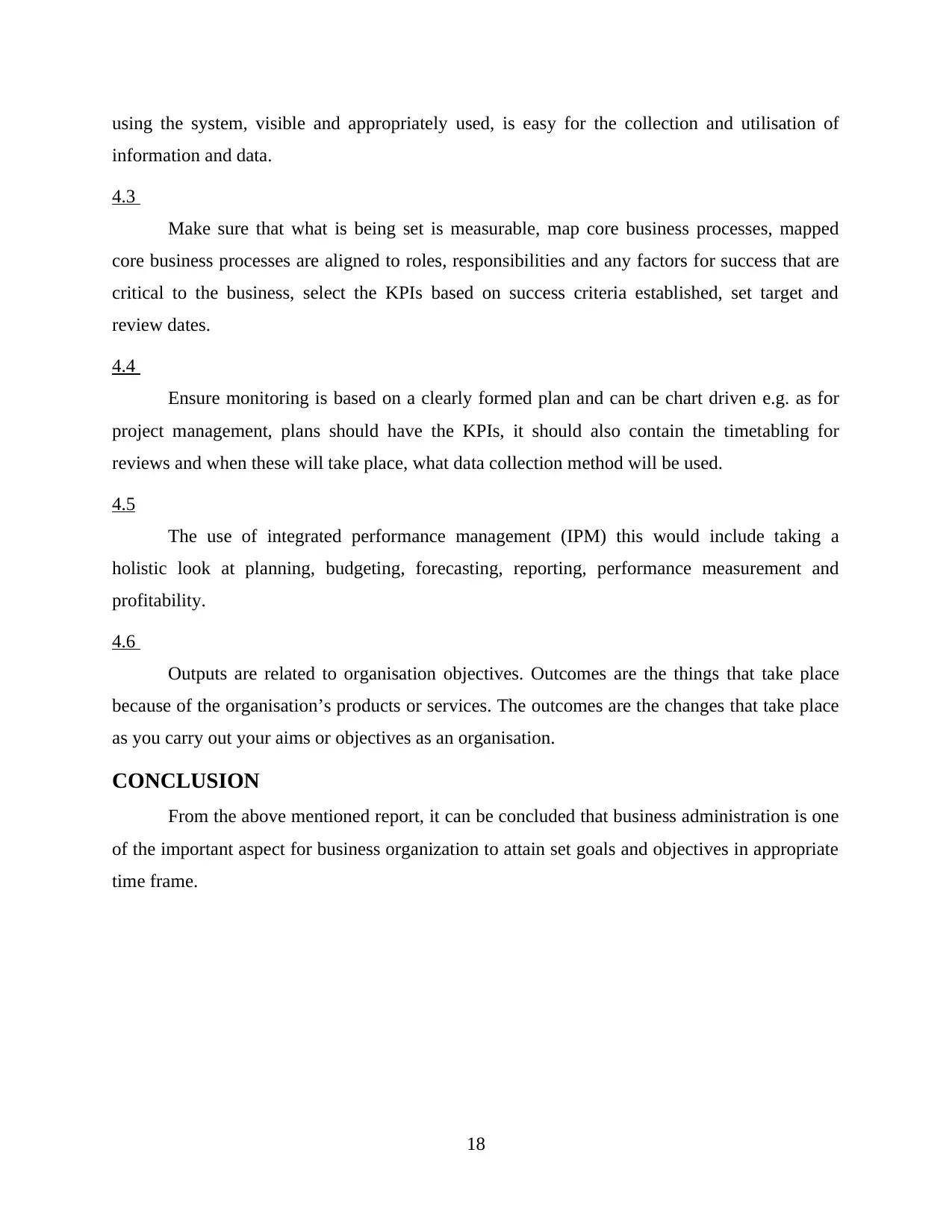
using the system, visible and appropriately used, is easy for the collection and utilisation of
information and data.
4.3
Make sure that what is being set is measurable, map core business processes, mapped
core business processes are aligned to roles, responsibilities and any factors for success that are
critical to the business, select the KPIs based on success criteria established, set target and
review dates.
4.4
Ensure monitoring is based on a clearly formed plan and can be chart driven e.g. as for
project management, plans should have the KPIs, it should also contain the timetabling for
reviews and when these will take place, what data collection method will be used.
4.5
The use of integrated performance management (IPM) this would include taking a
holistic look at planning, budgeting, forecasting, reporting, performance measurement and
profitability.
4.6
Outputs are related to organisation objectives. Outcomes are the things that take place
because of the organisation’s products or services. The outcomes are the changes that take place
as you carry out your aims or objectives as an organisation.
CONCLUSION
From the above mentioned report, it can be concluded that business administration is one
of the important aspect for business organization to attain set goals and objectives in appropriate
time frame.
18
information and data.
4.3
Make sure that what is being set is measurable, map core business processes, mapped
core business processes are aligned to roles, responsibilities and any factors for success that are
critical to the business, select the KPIs based on success criteria established, set target and
review dates.
4.4
Ensure monitoring is based on a clearly formed plan and can be chart driven e.g. as for
project management, plans should have the KPIs, it should also contain the timetabling for
reviews and when these will take place, what data collection method will be used.
4.5
The use of integrated performance management (IPM) this would include taking a
holistic look at planning, budgeting, forecasting, reporting, performance measurement and
profitability.
4.6
Outputs are related to organisation objectives. Outcomes are the things that take place
because of the organisation’s products or services. The outcomes are the changes that take place
as you carry out your aims or objectives as an organisation.
CONCLUSION
From the above mentioned report, it can be concluded that business administration is one
of the important aspect for business organization to attain set goals and objectives in appropriate
time frame.
18
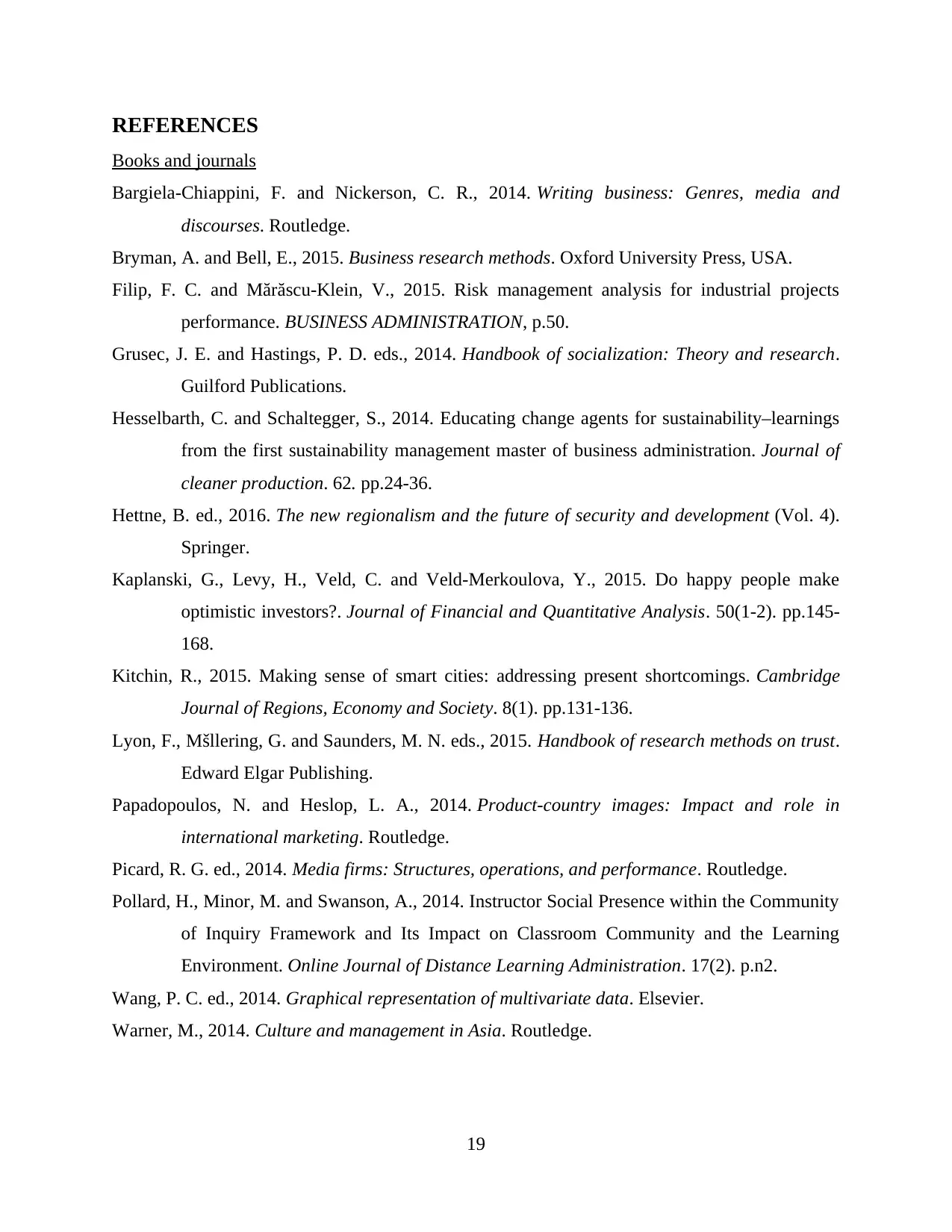
REFERENCES
Books and journals
Bargiela-Chiappini, F. and Nickerson, C. R., 2014. Writing business: Genres, media and
discourses. Routledge.
Bryman, A. and Bell, E., 2015. Business research methods. Oxford University Press, USA.
Filip, F. C. and Mărăscu-Klein, V., 2015. Risk management analysis for industrial projects
performance. BUSINESS ADMINISTRATION, p.50.
Grusec, J. E. and Hastings, P. D. eds., 2014. Handbook of socialization: Theory and research.
Guilford Publications.
Hesselbarth, C. and Schaltegger, S., 2014. Educating change agents for sustainability–learnings
from the first sustainability management master of business administration. Journal of
cleaner production. 62. pp.24-36.
Hettne, B. ed., 2016. The new regionalism and the future of security and development (Vol. 4).
Springer.
Kaplanski, G., Levy, H., Veld, C. and Veld-Merkoulova, Y., 2015. Do happy people make
optimistic investors?. Journal of Financial and Quantitative Analysis. 50(1-2). pp.145-
168.
Kitchin, R., 2015. Making sense of smart cities: addressing present shortcomings. Cambridge
Journal of Regions, Economy and Society. 8(1). pp.131-136.
Lyon, F., Mšllering, G. and Saunders, M. N. eds., 2015. Handbook of research methods on trust.
Edward Elgar Publishing.
Papadopoulos, N. and Heslop, L. A., 2014. Product-country images: Impact and role in
international marketing. Routledge.
Picard, R. G. ed., 2014. Media firms: Structures, operations, and performance. Routledge.
Pollard, H., Minor, M. and Swanson, A., 2014. Instructor Social Presence within the Community
of Inquiry Framework and Its Impact on Classroom Community and the Learning
Environment. Online Journal of Distance Learning Administration. 17(2). p.n2.
Wang, P. C. ed., 2014. Graphical representation of multivariate data. Elsevier.
Warner, M., 2014. Culture and management in Asia. Routledge.
19
Books and journals
Bargiela-Chiappini, F. and Nickerson, C. R., 2014. Writing business: Genres, media and
discourses. Routledge.
Bryman, A. and Bell, E., 2015. Business research methods. Oxford University Press, USA.
Filip, F. C. and Mărăscu-Klein, V., 2015. Risk management analysis for industrial projects
performance. BUSINESS ADMINISTRATION, p.50.
Grusec, J. E. and Hastings, P. D. eds., 2014. Handbook of socialization: Theory and research.
Guilford Publications.
Hesselbarth, C. and Schaltegger, S., 2014. Educating change agents for sustainability–learnings
from the first sustainability management master of business administration. Journal of
cleaner production. 62. pp.24-36.
Hettne, B. ed., 2016. The new regionalism and the future of security and development (Vol. 4).
Springer.
Kaplanski, G., Levy, H., Veld, C. and Veld-Merkoulova, Y., 2015. Do happy people make
optimistic investors?. Journal of Financial and Quantitative Analysis. 50(1-2). pp.145-
168.
Kitchin, R., 2015. Making sense of smart cities: addressing present shortcomings. Cambridge
Journal of Regions, Economy and Society. 8(1). pp.131-136.
Lyon, F., Mšllering, G. and Saunders, M. N. eds., 2015. Handbook of research methods on trust.
Edward Elgar Publishing.
Papadopoulos, N. and Heslop, L. A., 2014. Product-country images: Impact and role in
international marketing. Routledge.
Picard, R. G. ed., 2014. Media firms: Structures, operations, and performance. Routledge.
Pollard, H., Minor, M. and Swanson, A., 2014. Instructor Social Presence within the Community
of Inquiry Framework and Its Impact on Classroom Community and the Learning
Environment. Online Journal of Distance Learning Administration. 17(2). p.n2.
Wang, P. C. ed., 2014. Graphical representation of multivariate data. Elsevier.
Warner, M., 2014. Culture and management in Asia. Routledge.
19
Paraphrase This Document
Need a fresh take? Get an instant paraphrase of this document with our AI Paraphraser
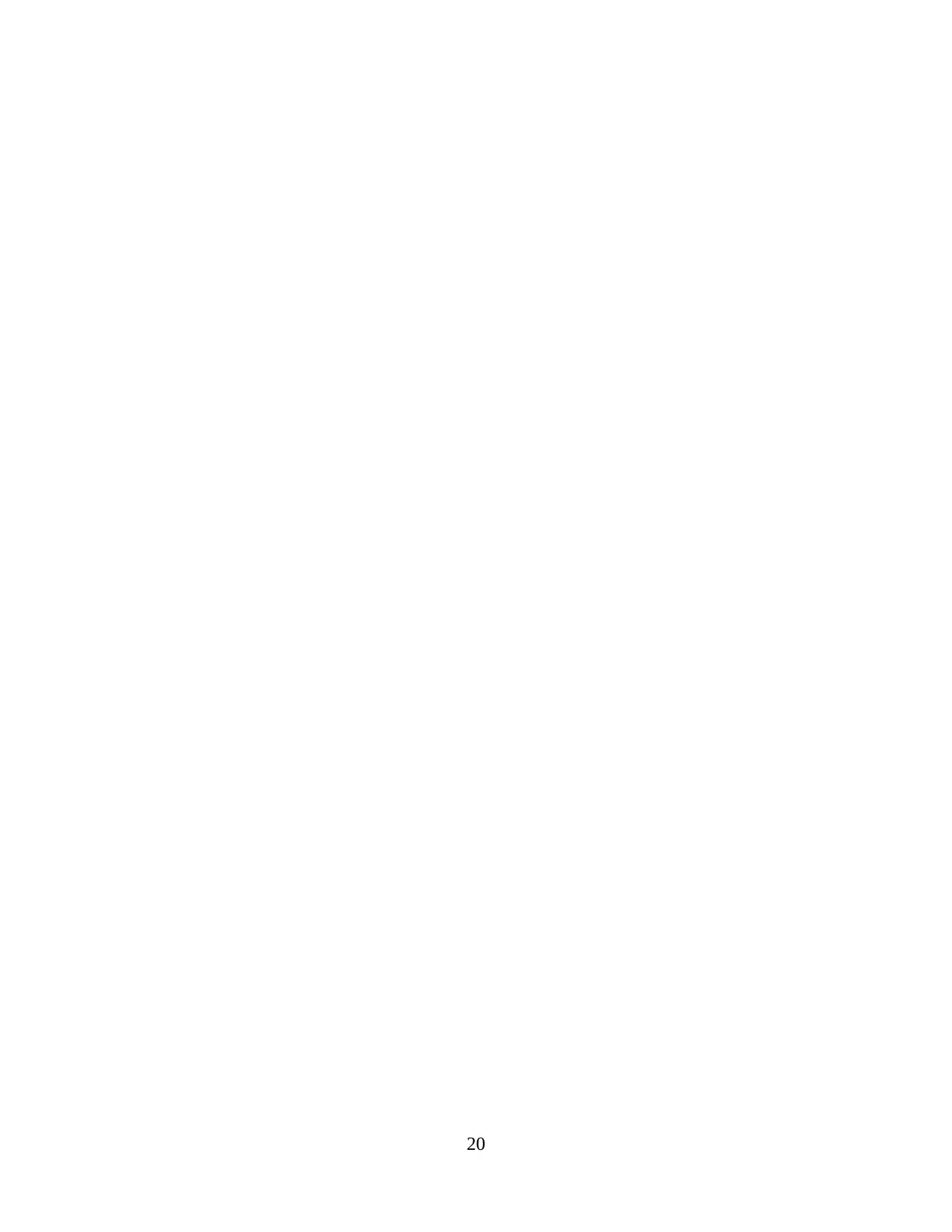
20
1 out of 26
Related Documents
Your All-in-One AI-Powered Toolkit for Academic Success.
+13062052269
info@desklib.com
Available 24*7 on WhatsApp / Email
![[object Object]](/_next/static/media/star-bottom.7253800d.svg)
Unlock your academic potential
© 2024 | Zucol Services PVT LTD | All rights reserved.





